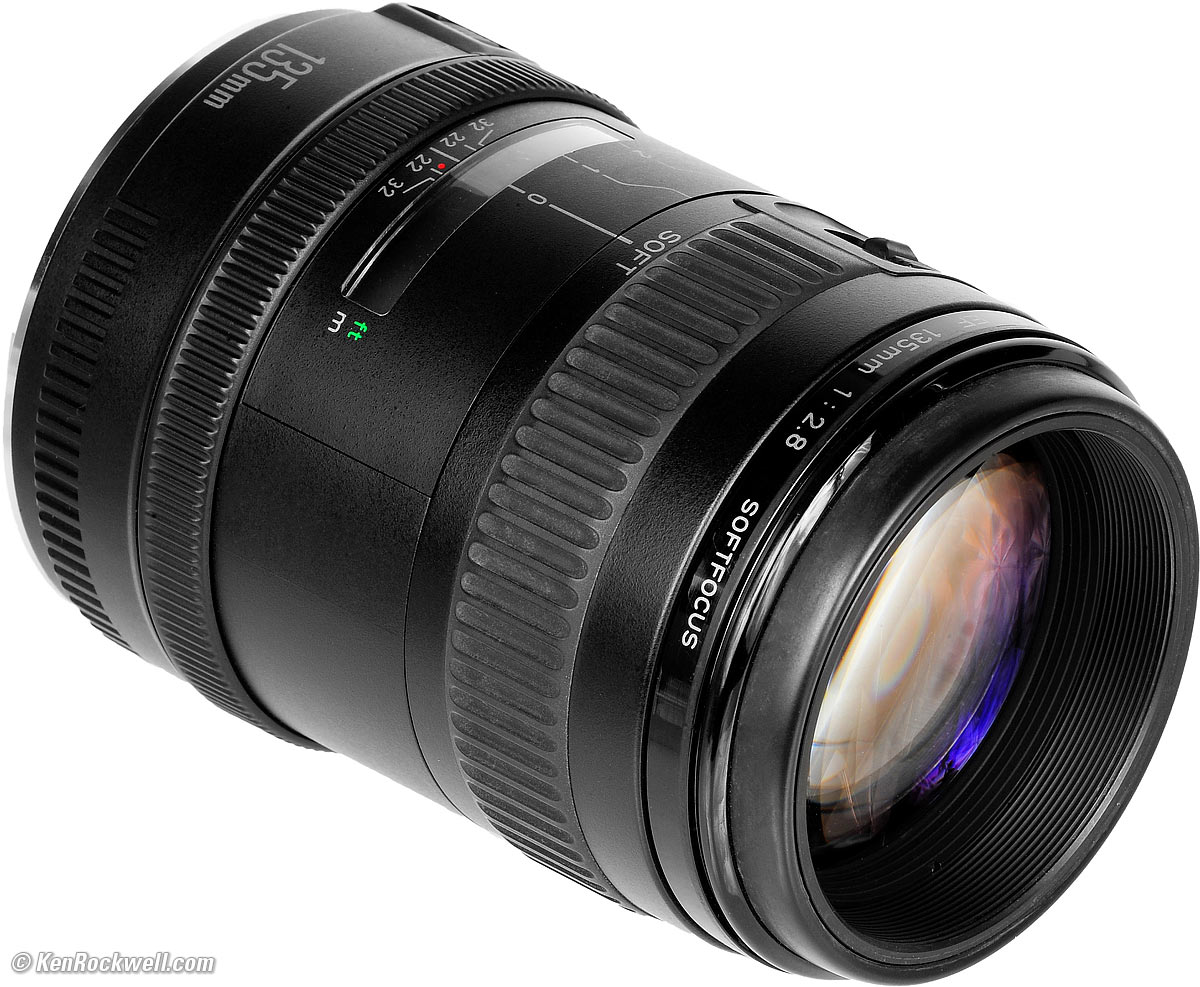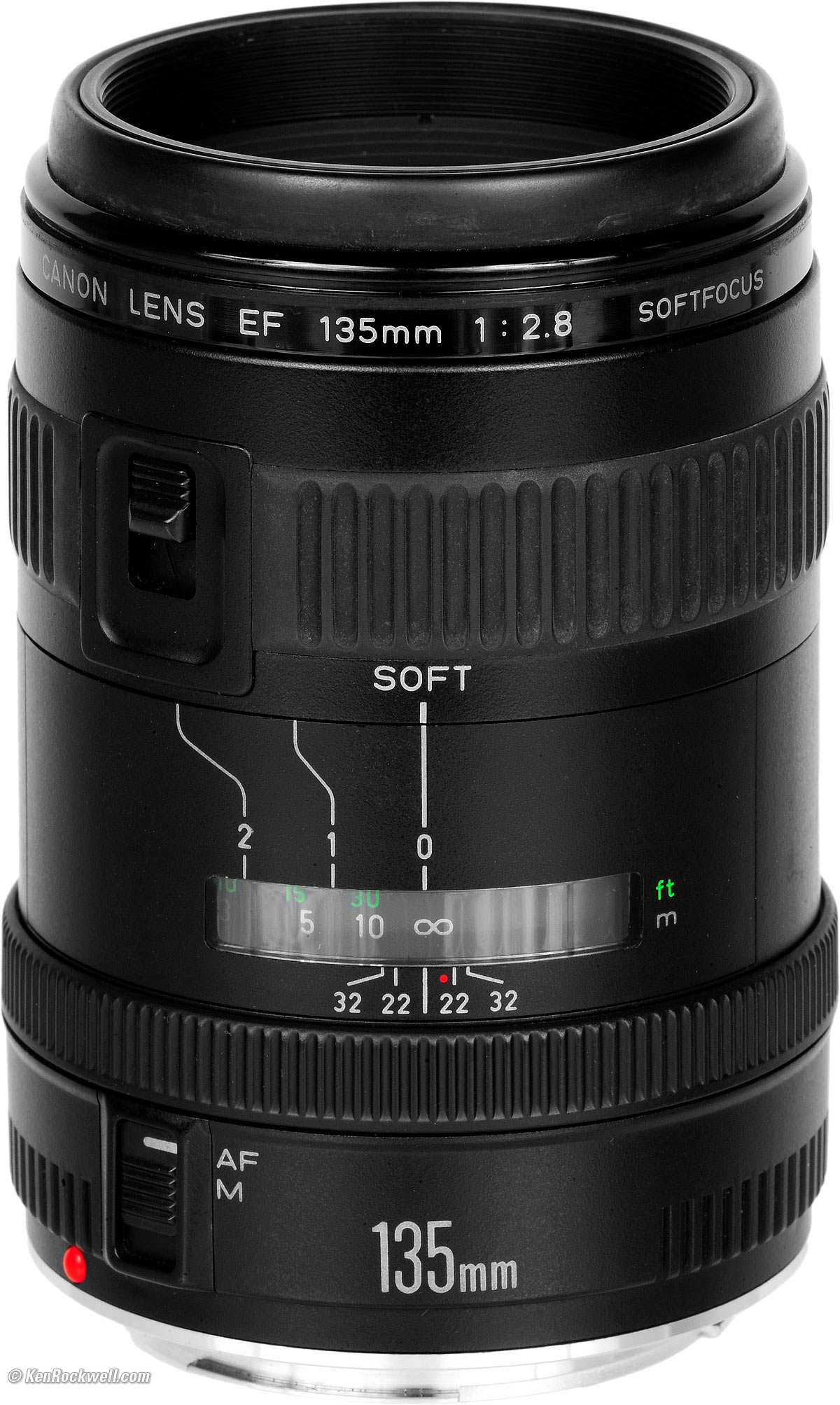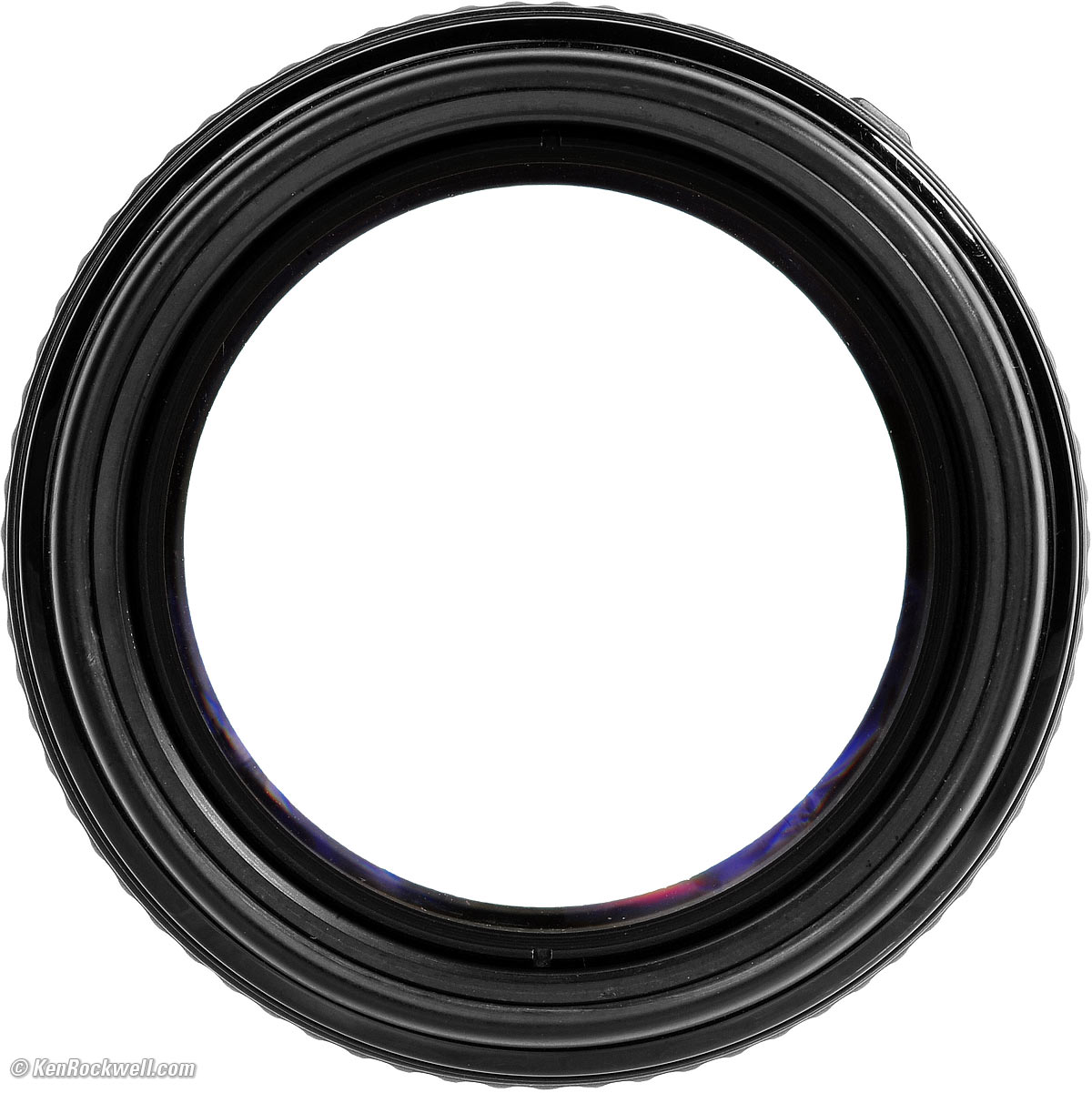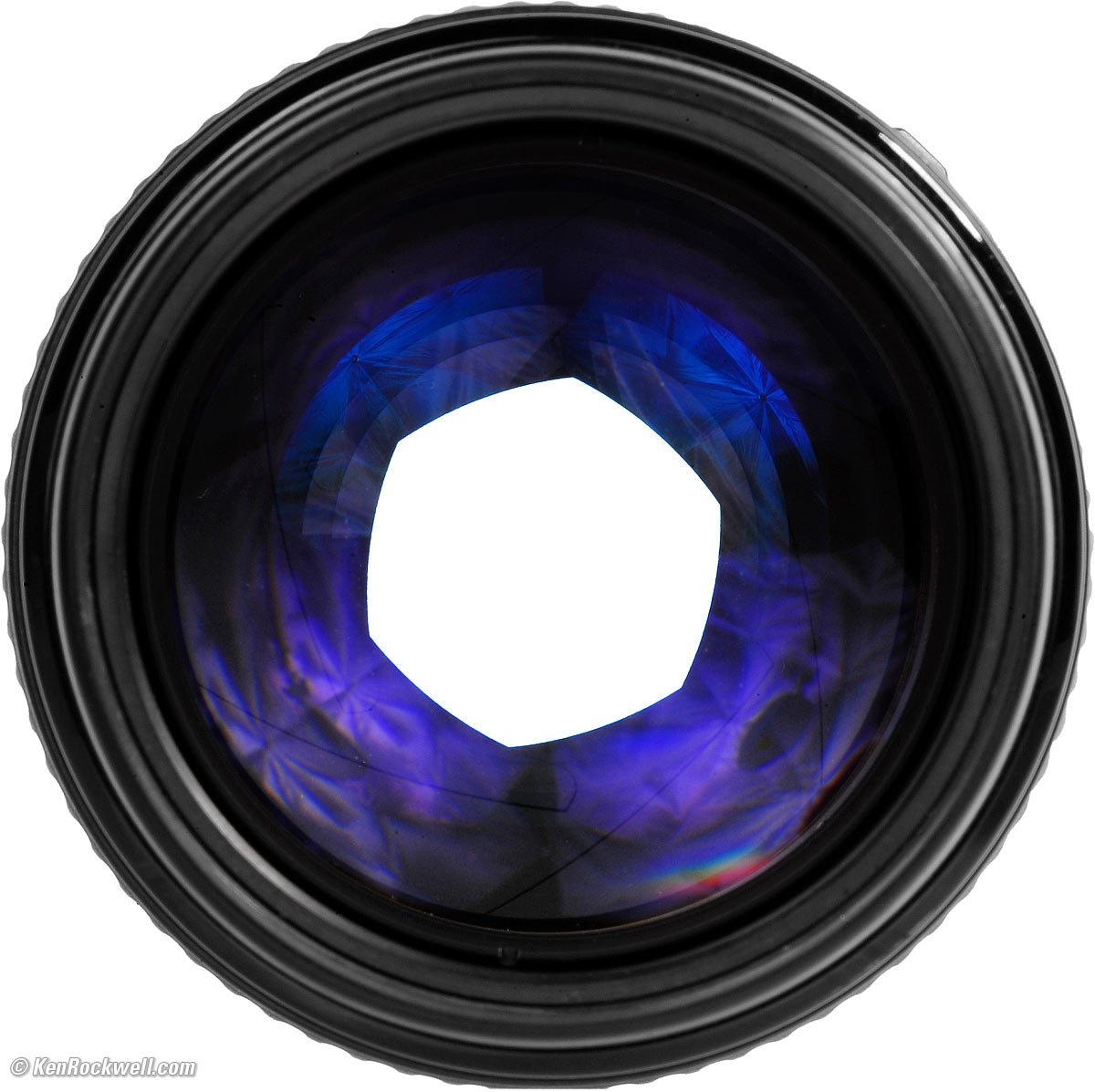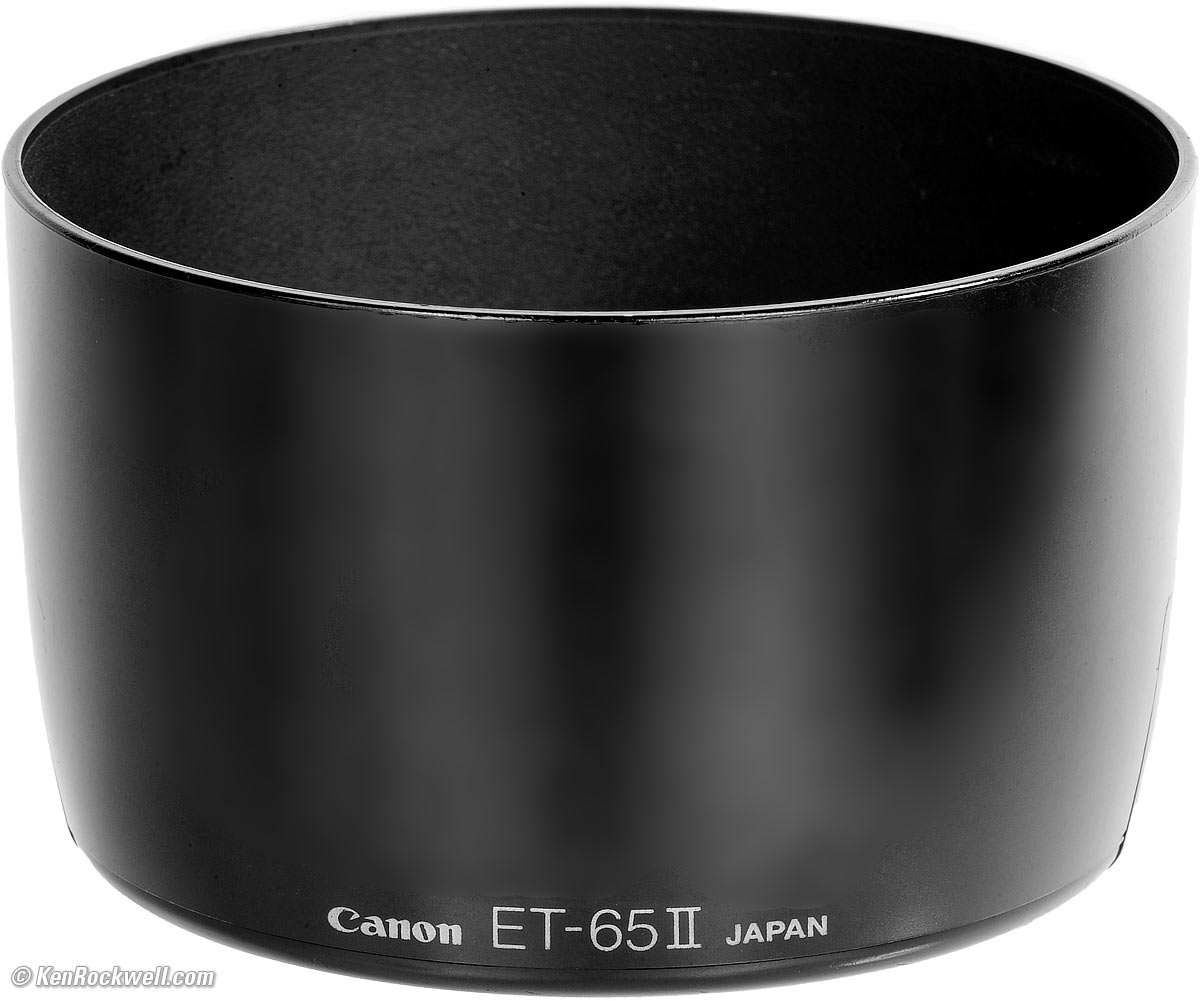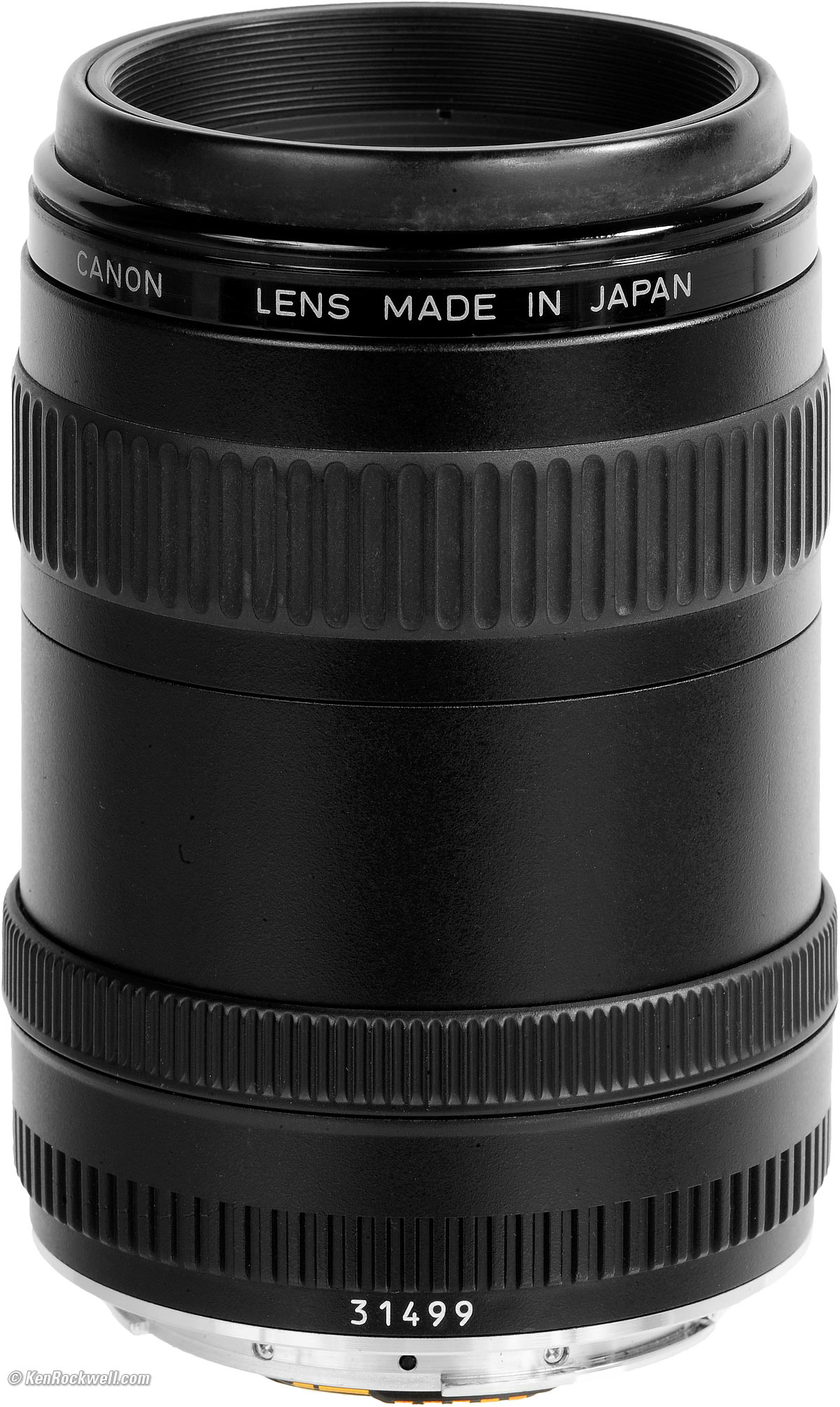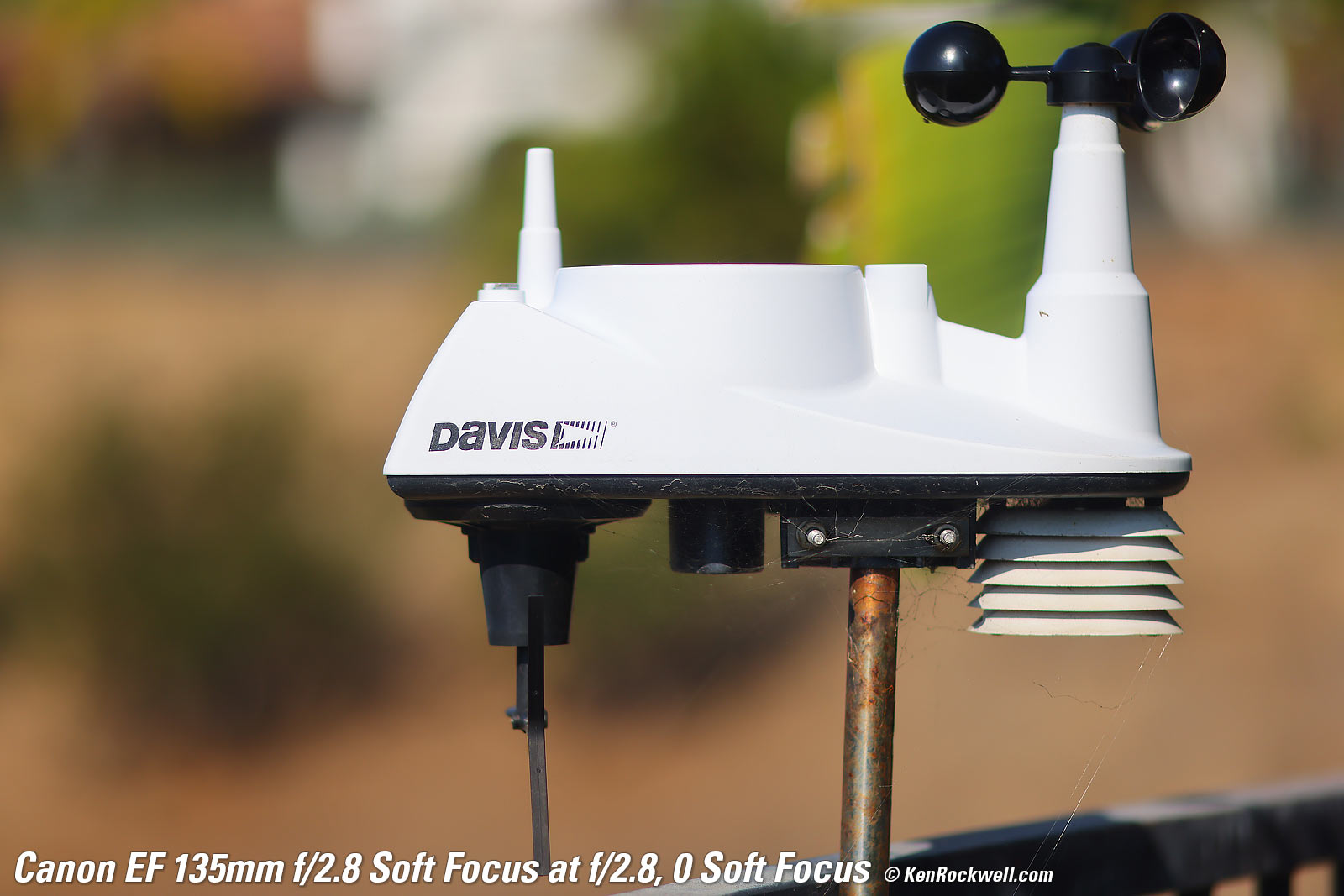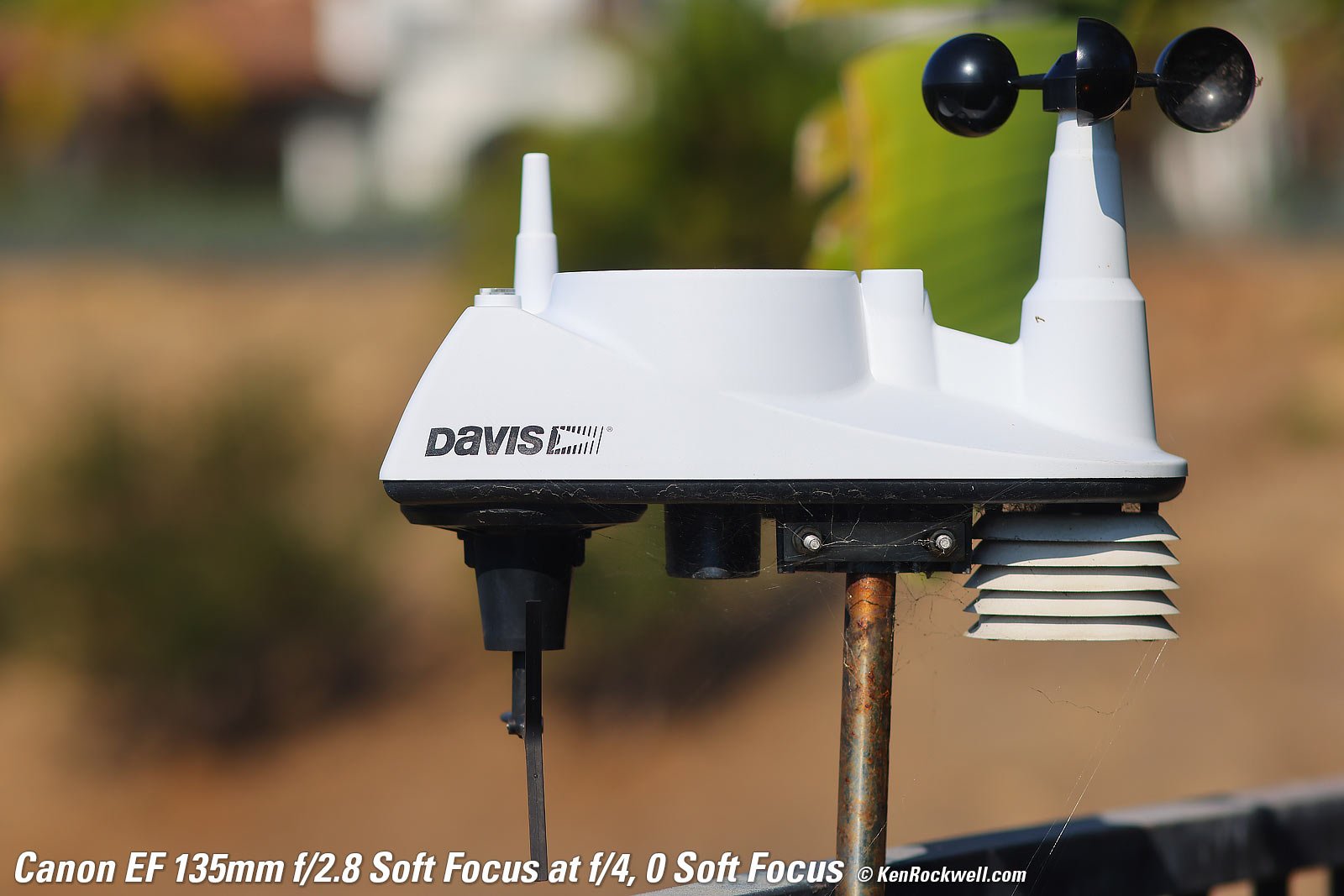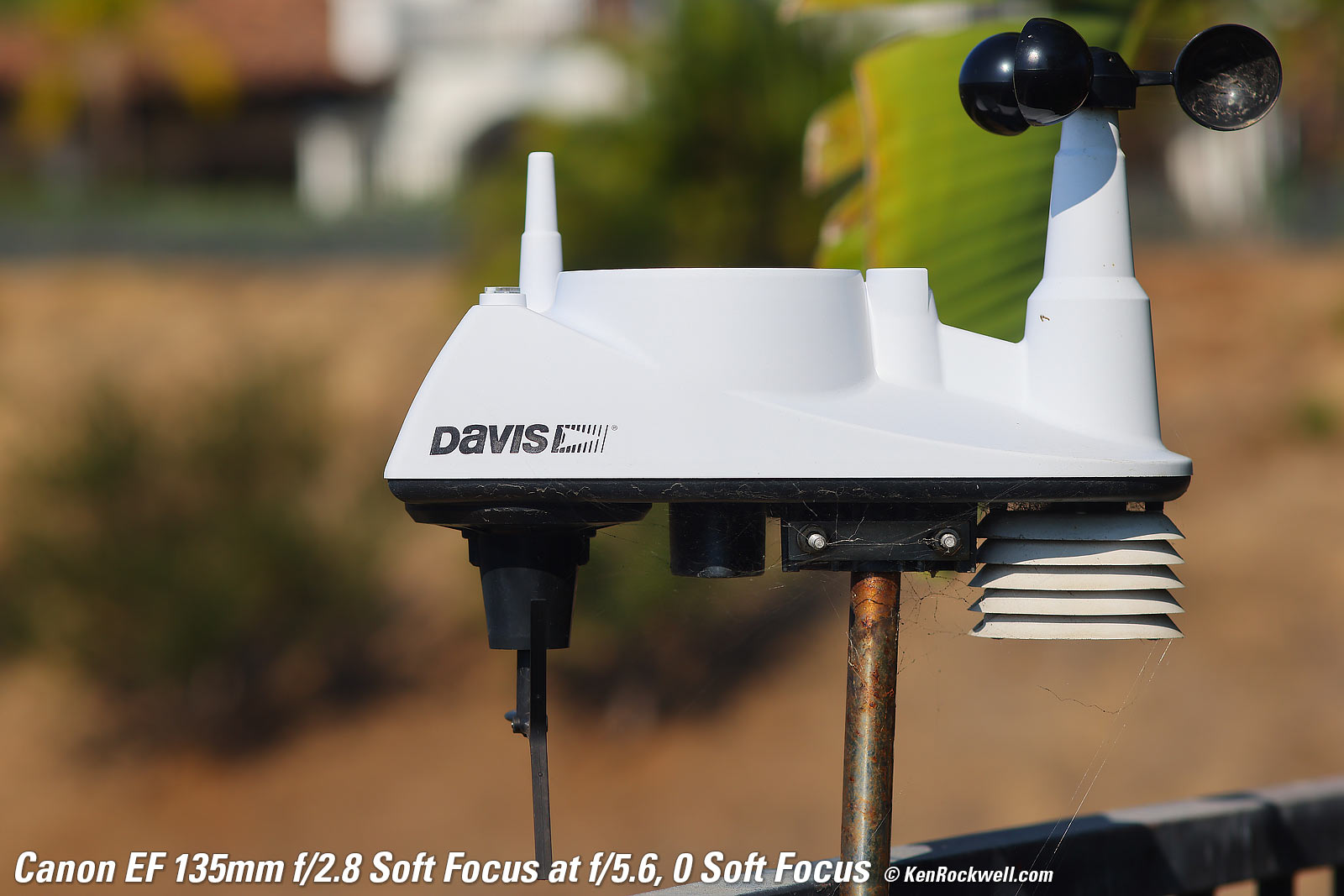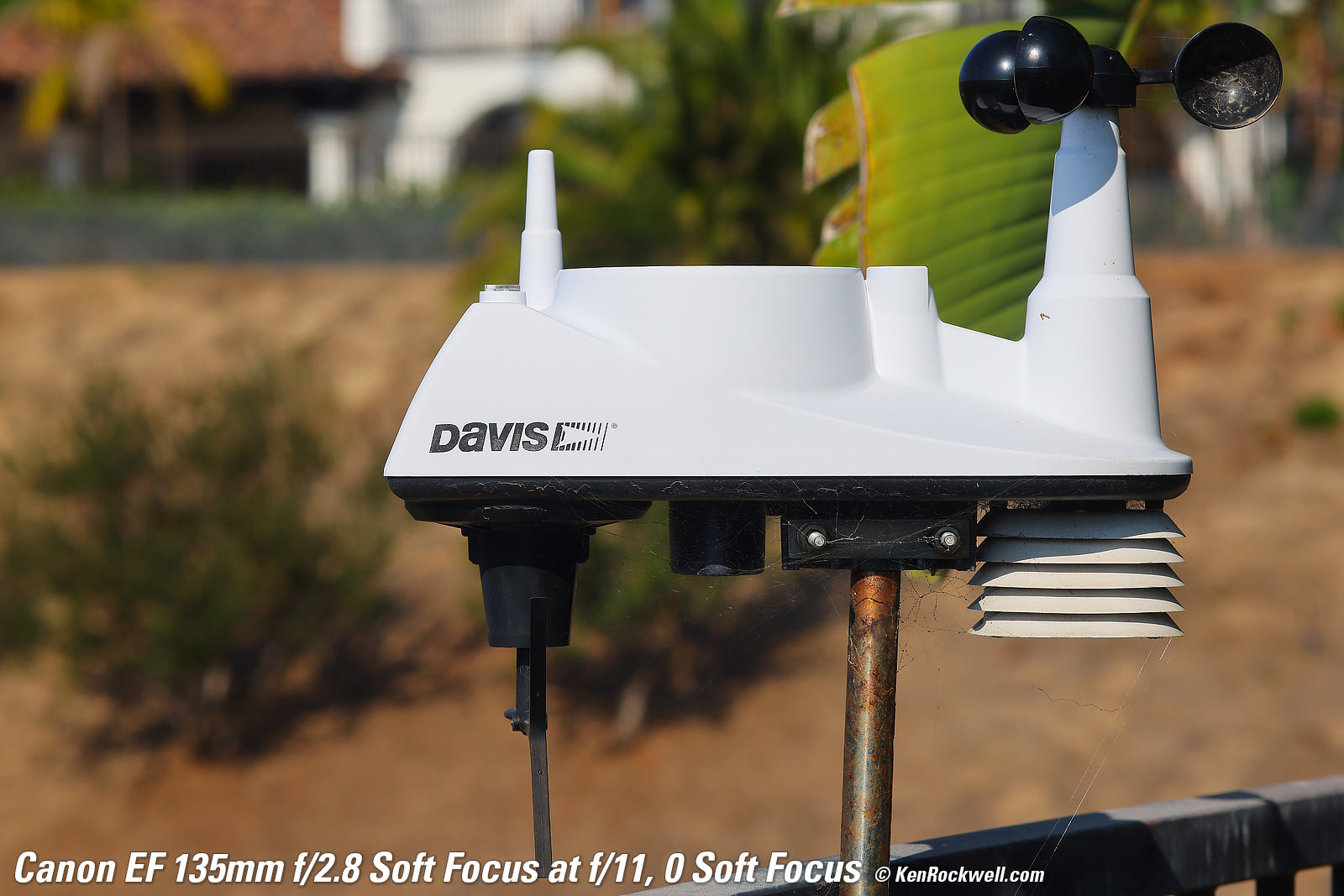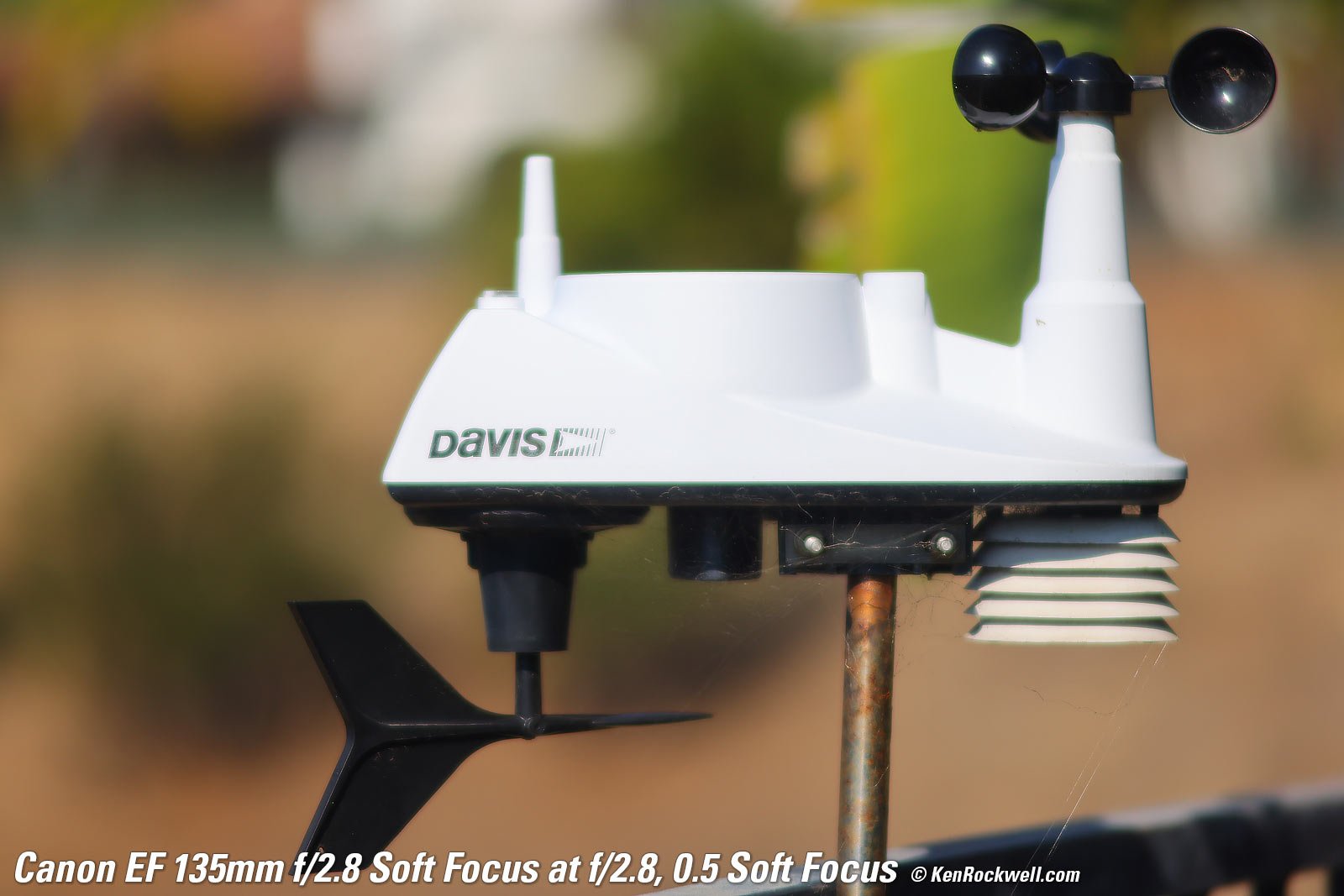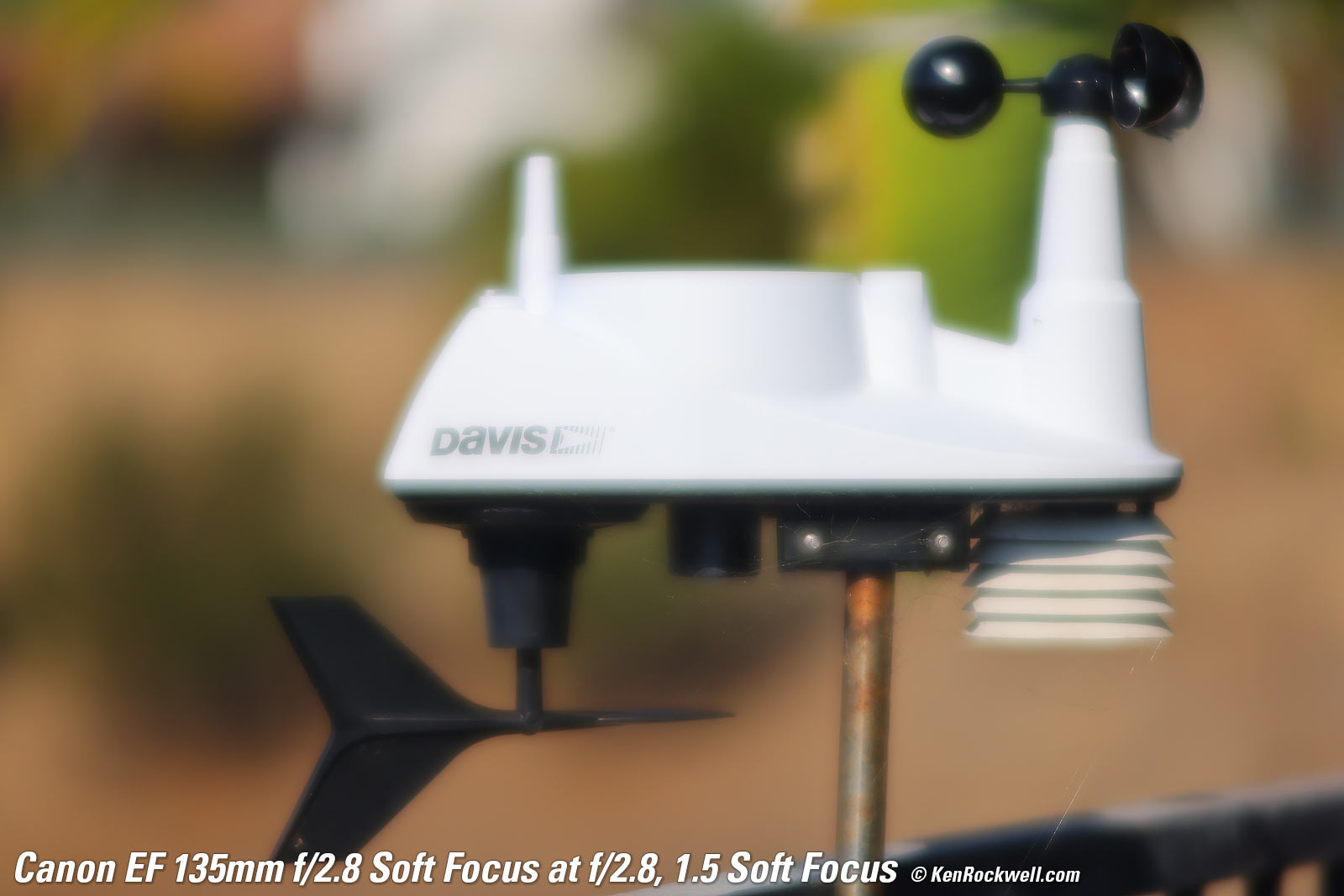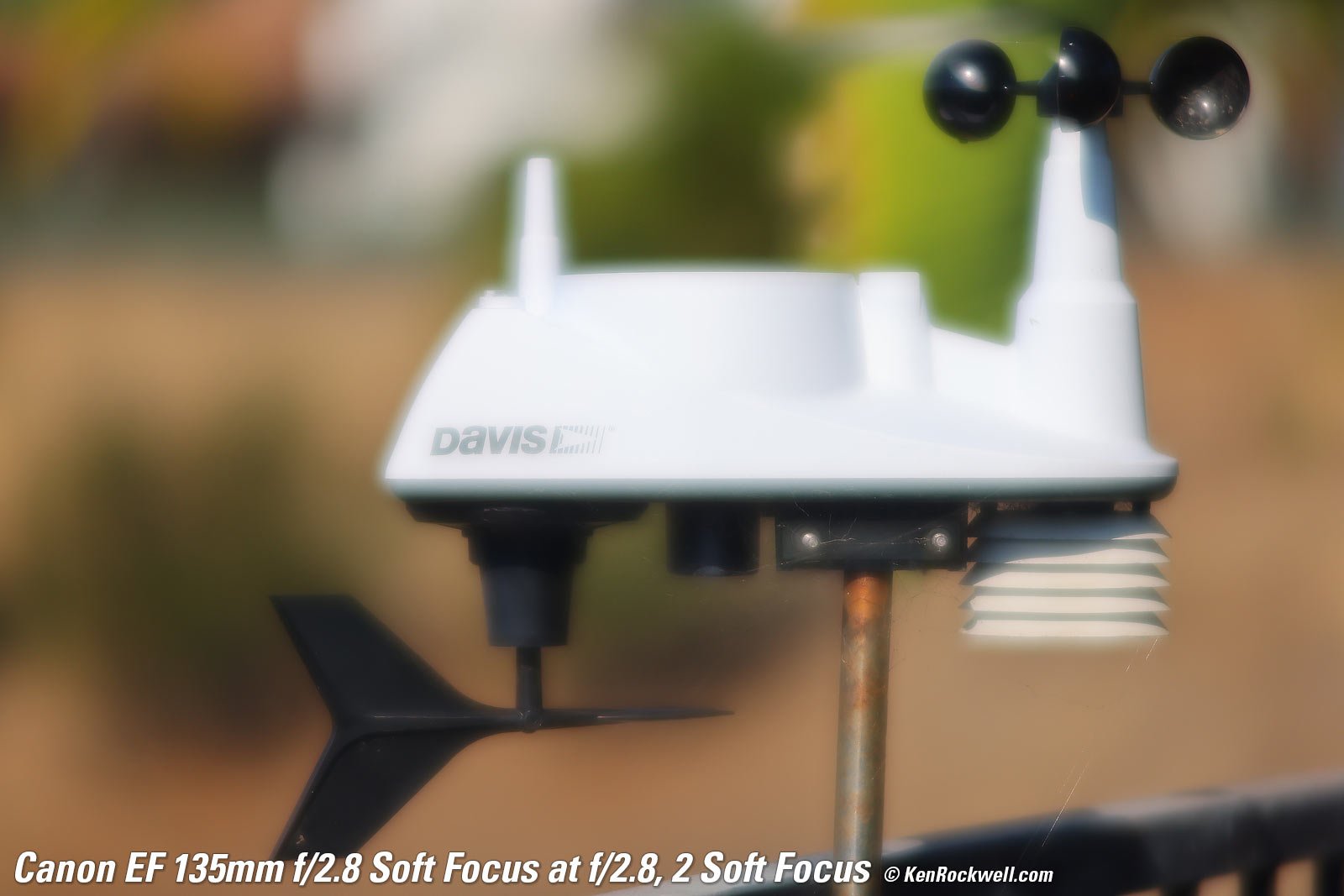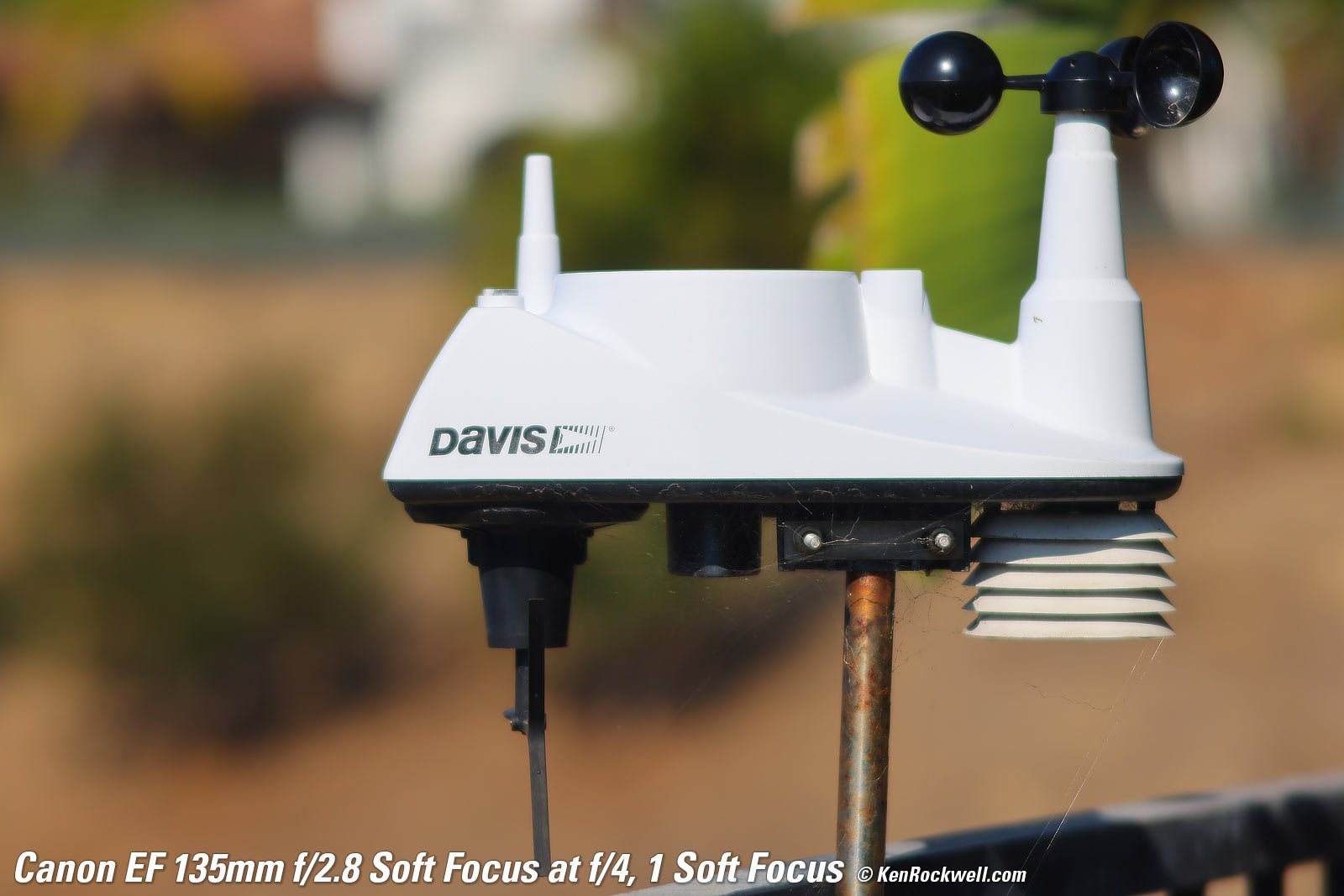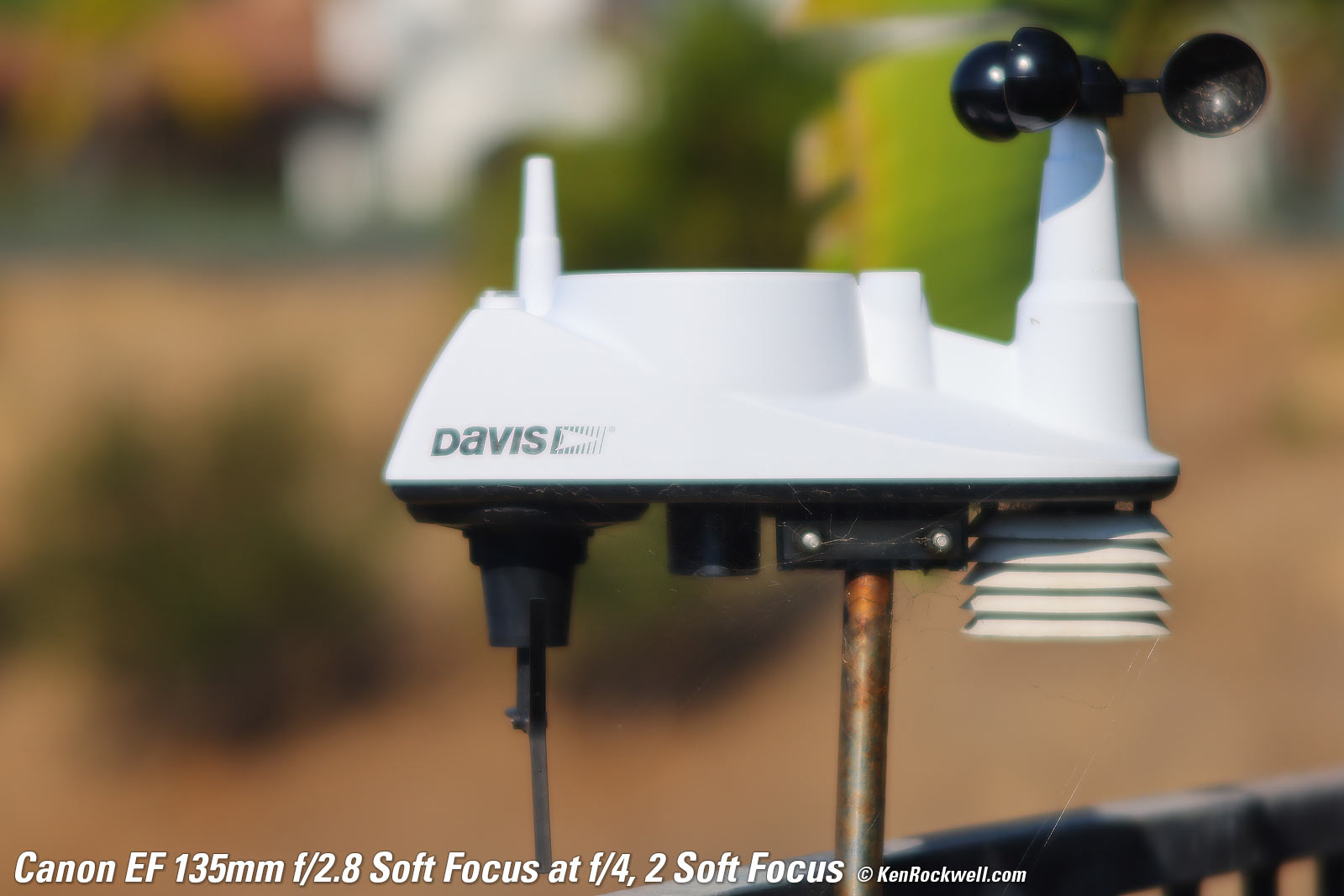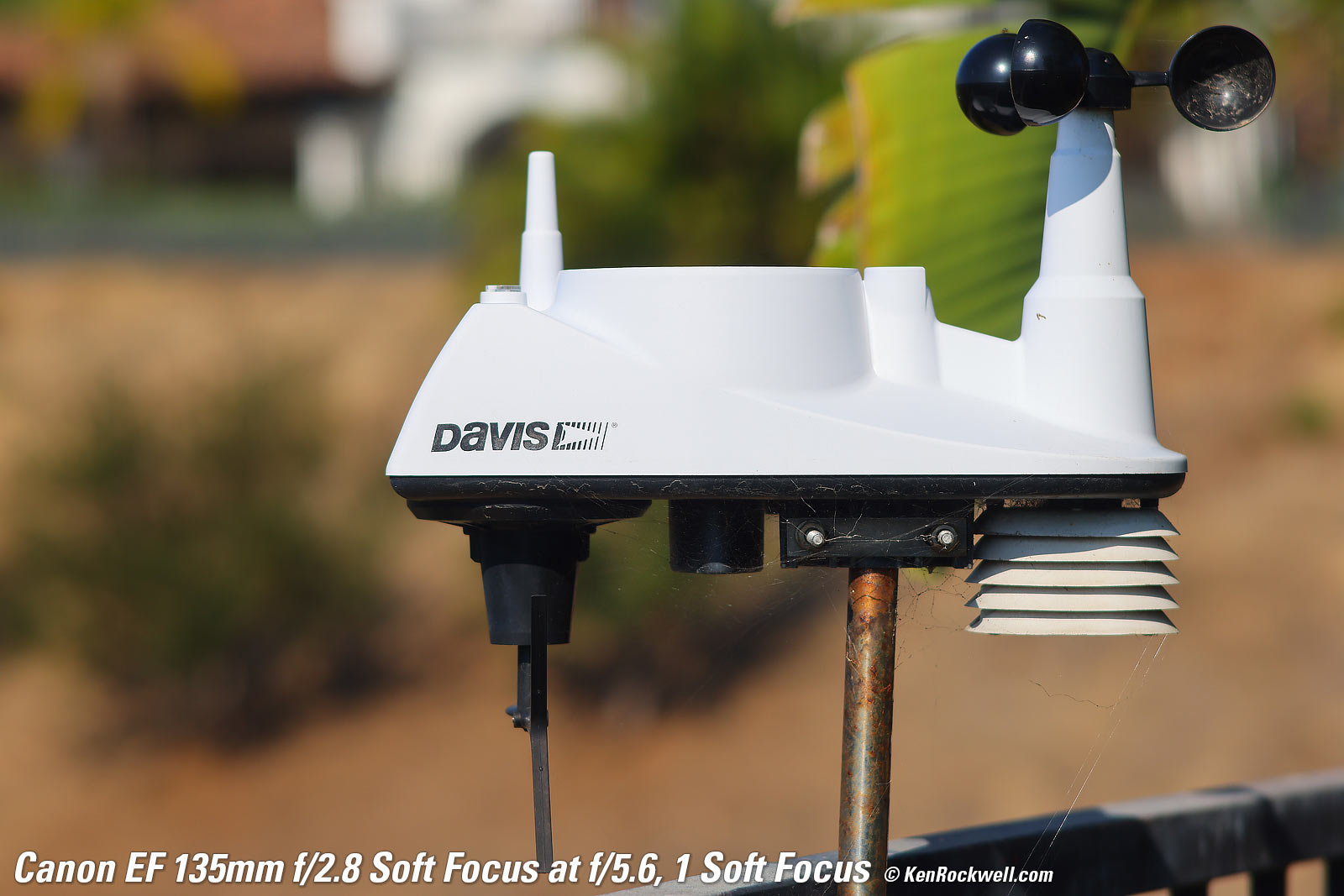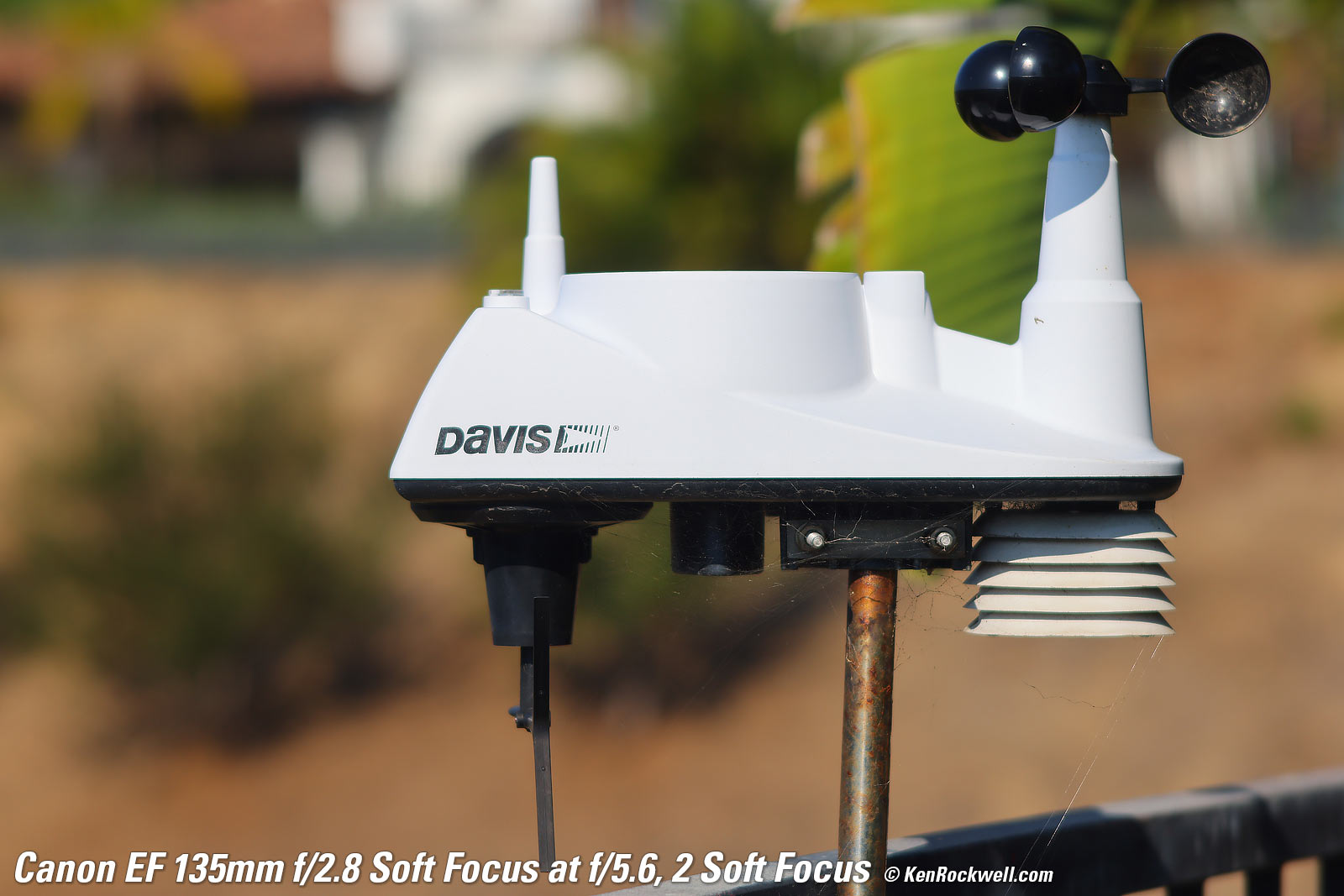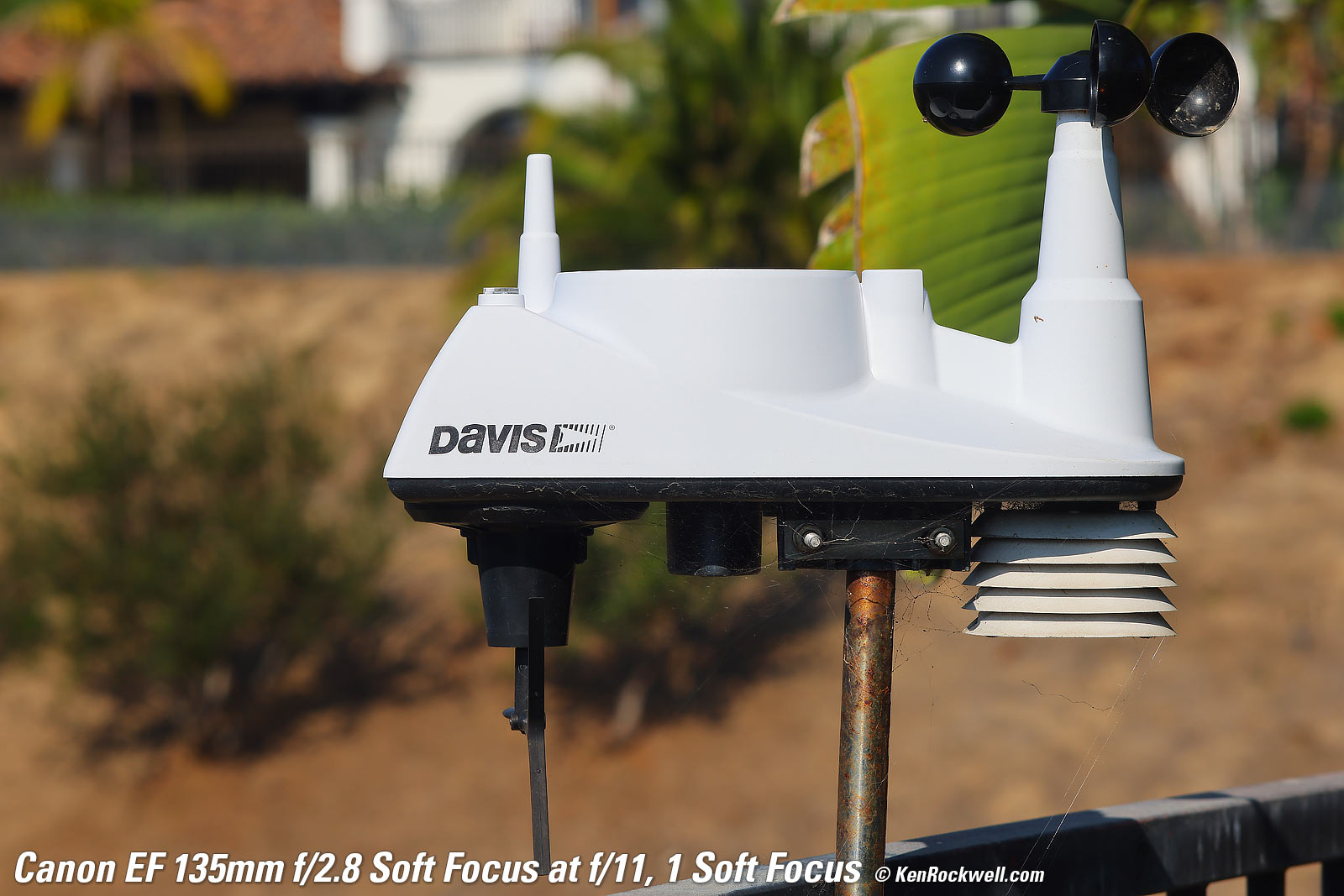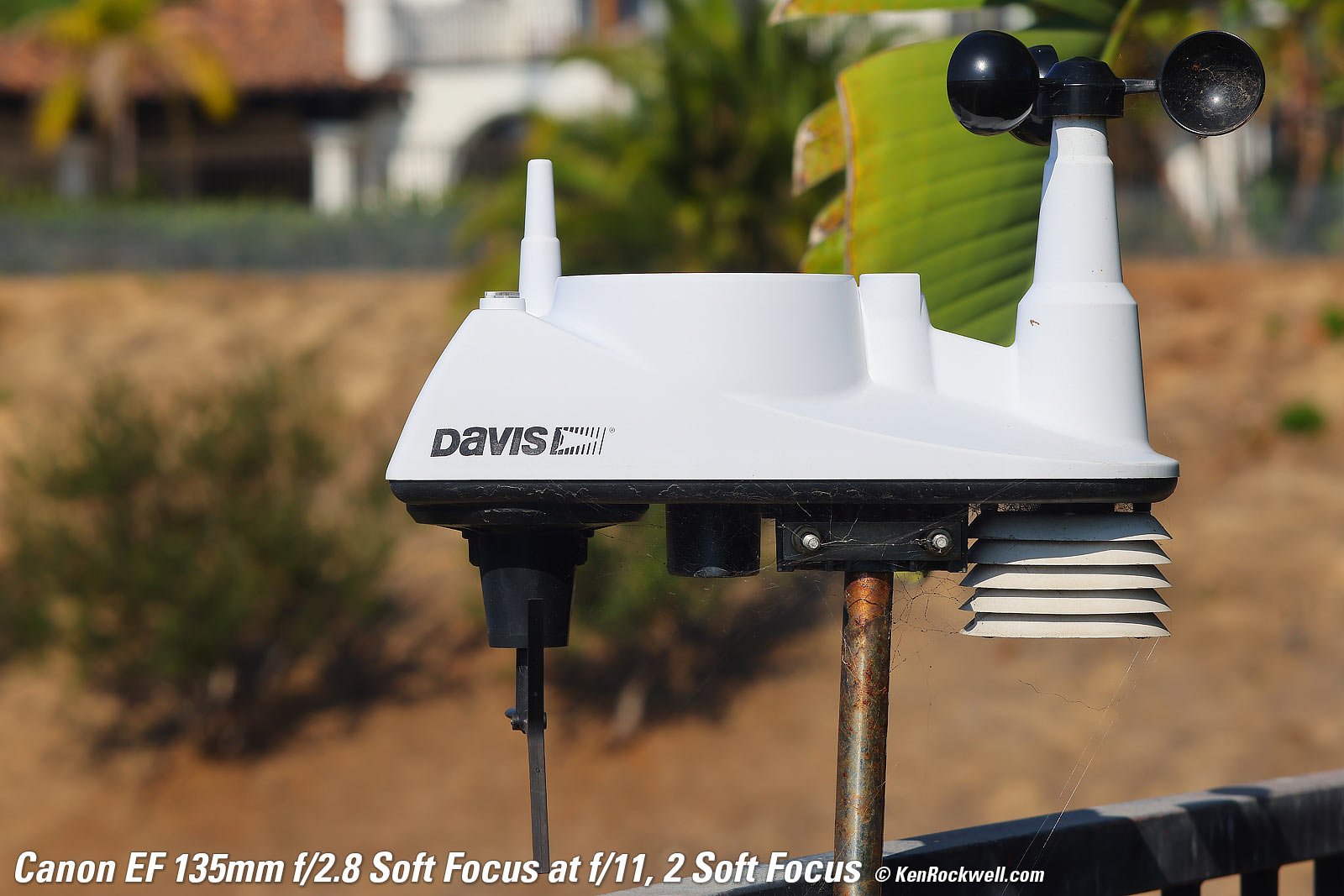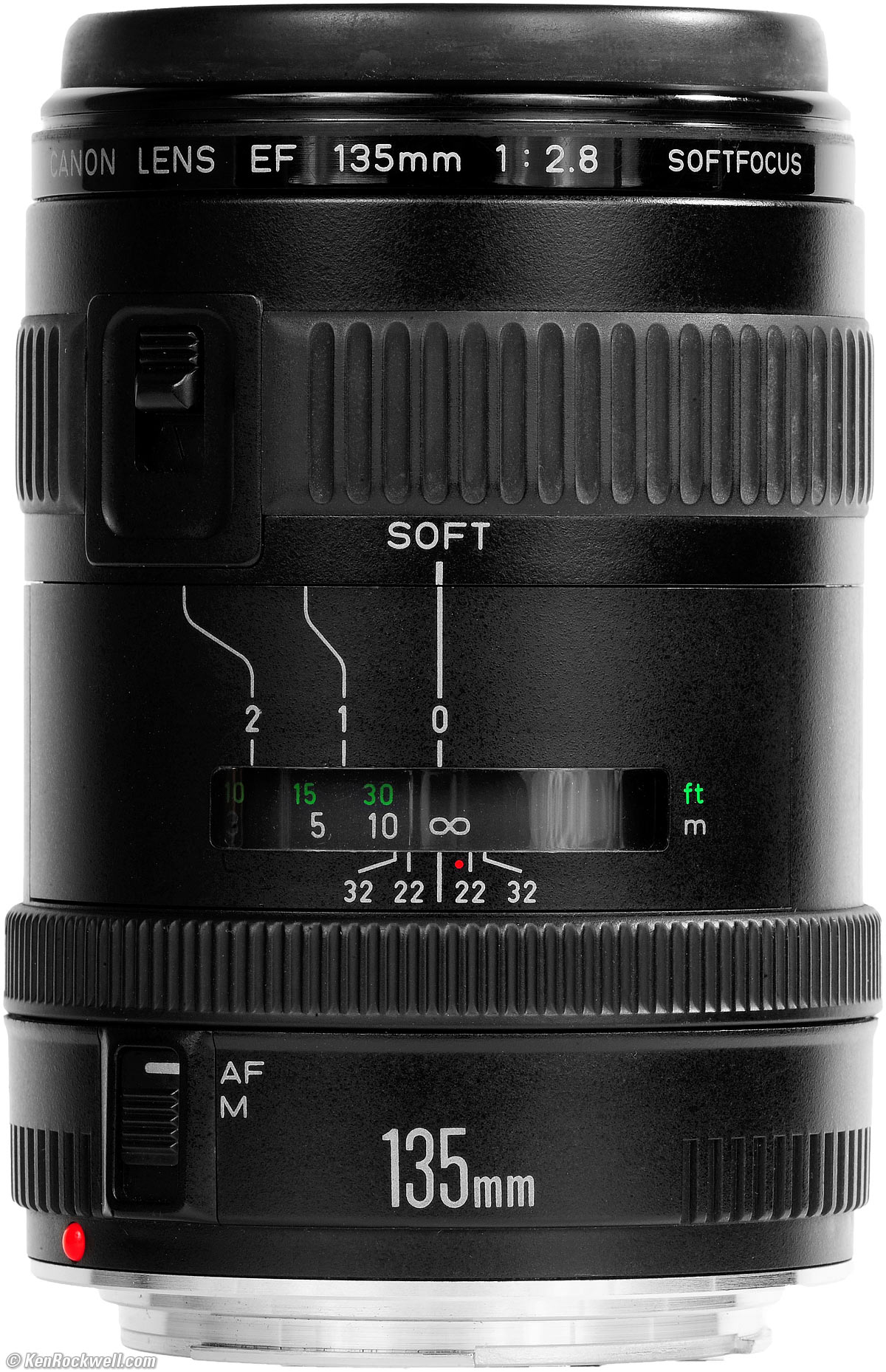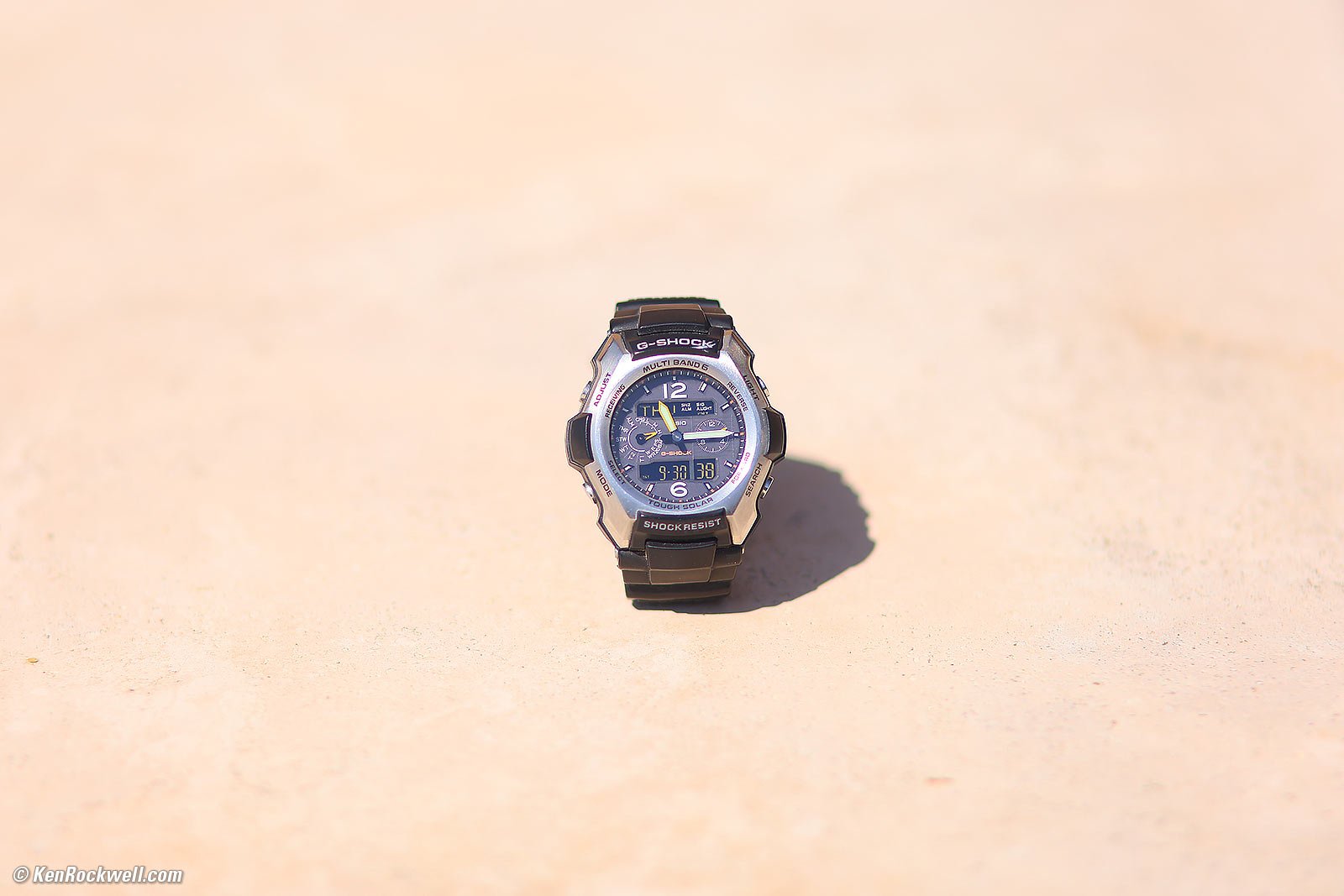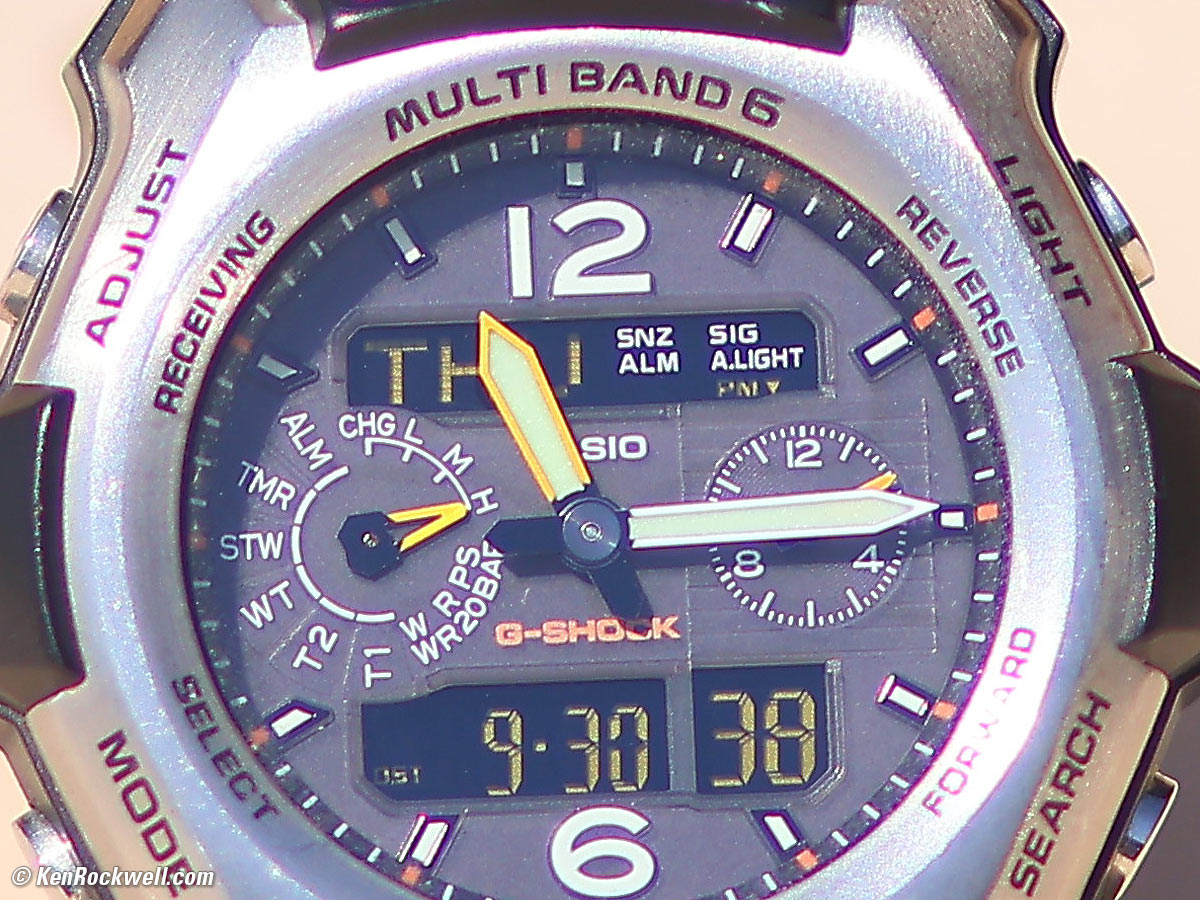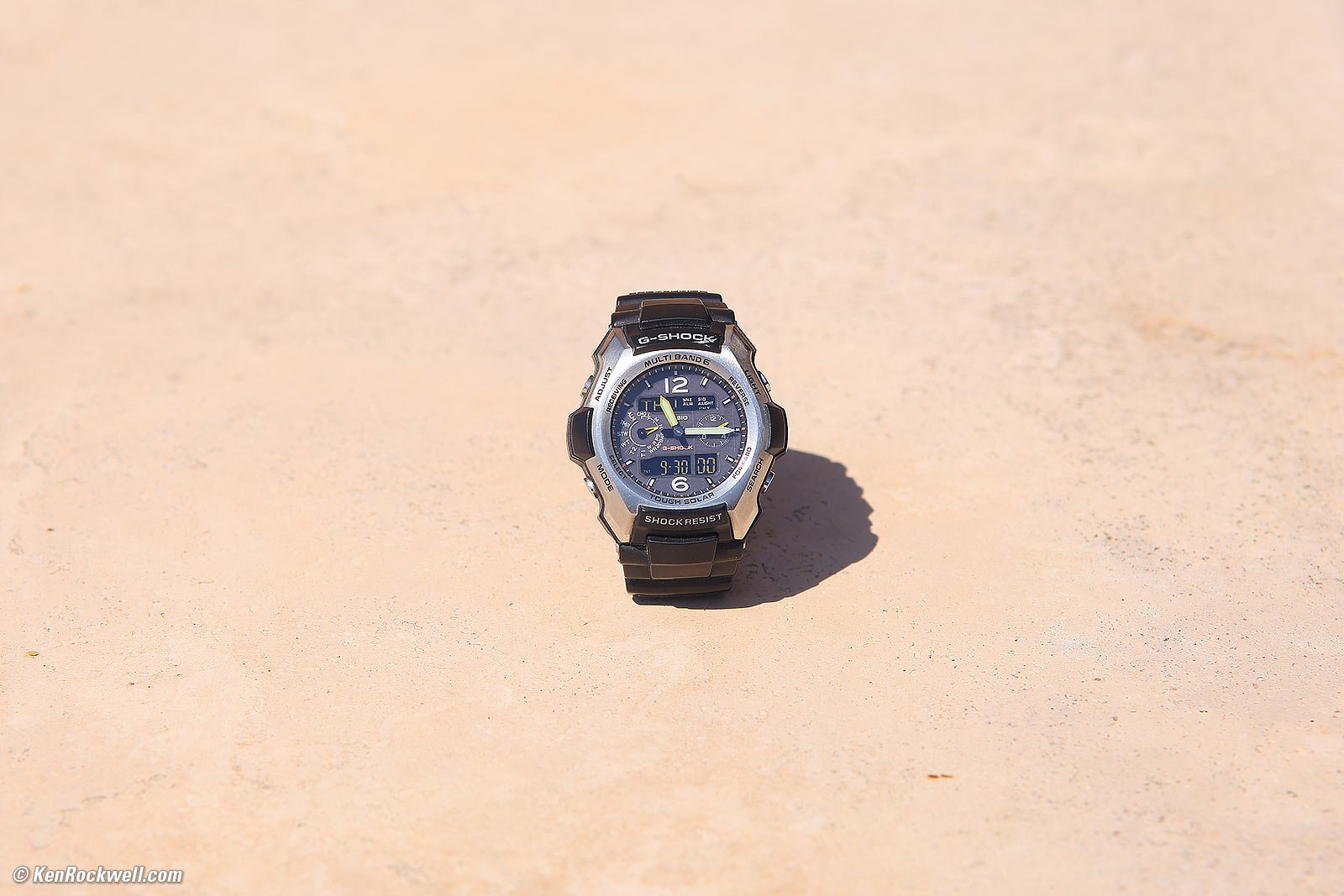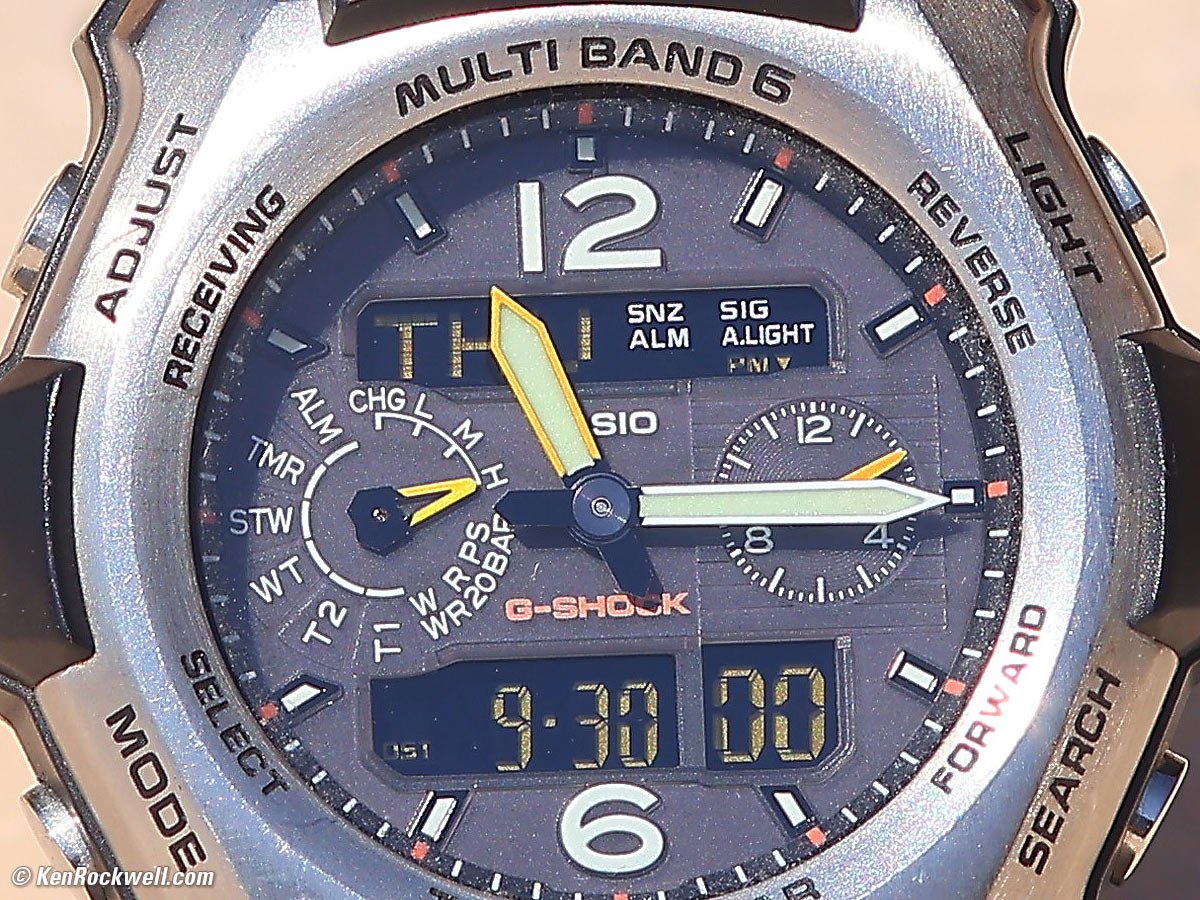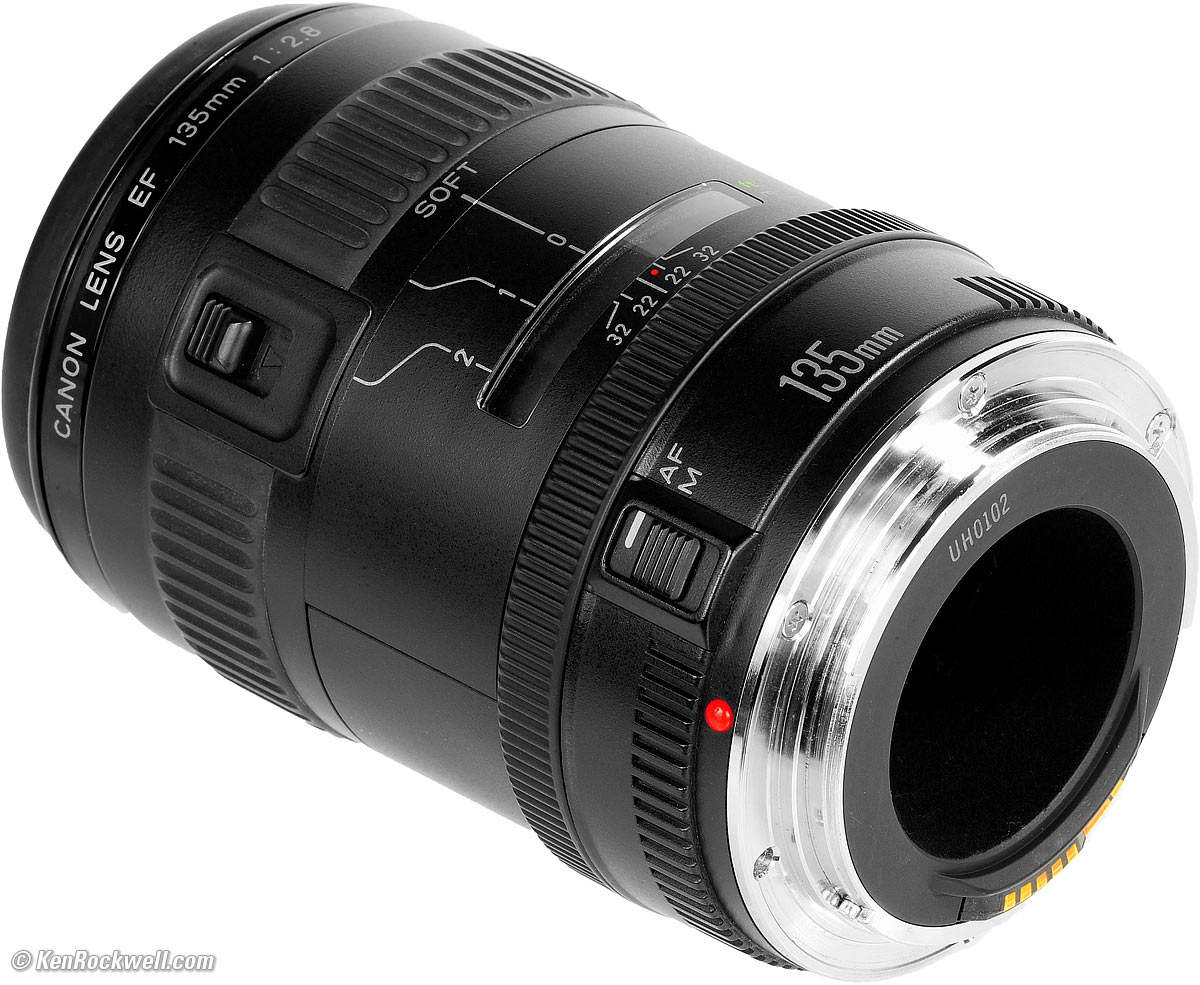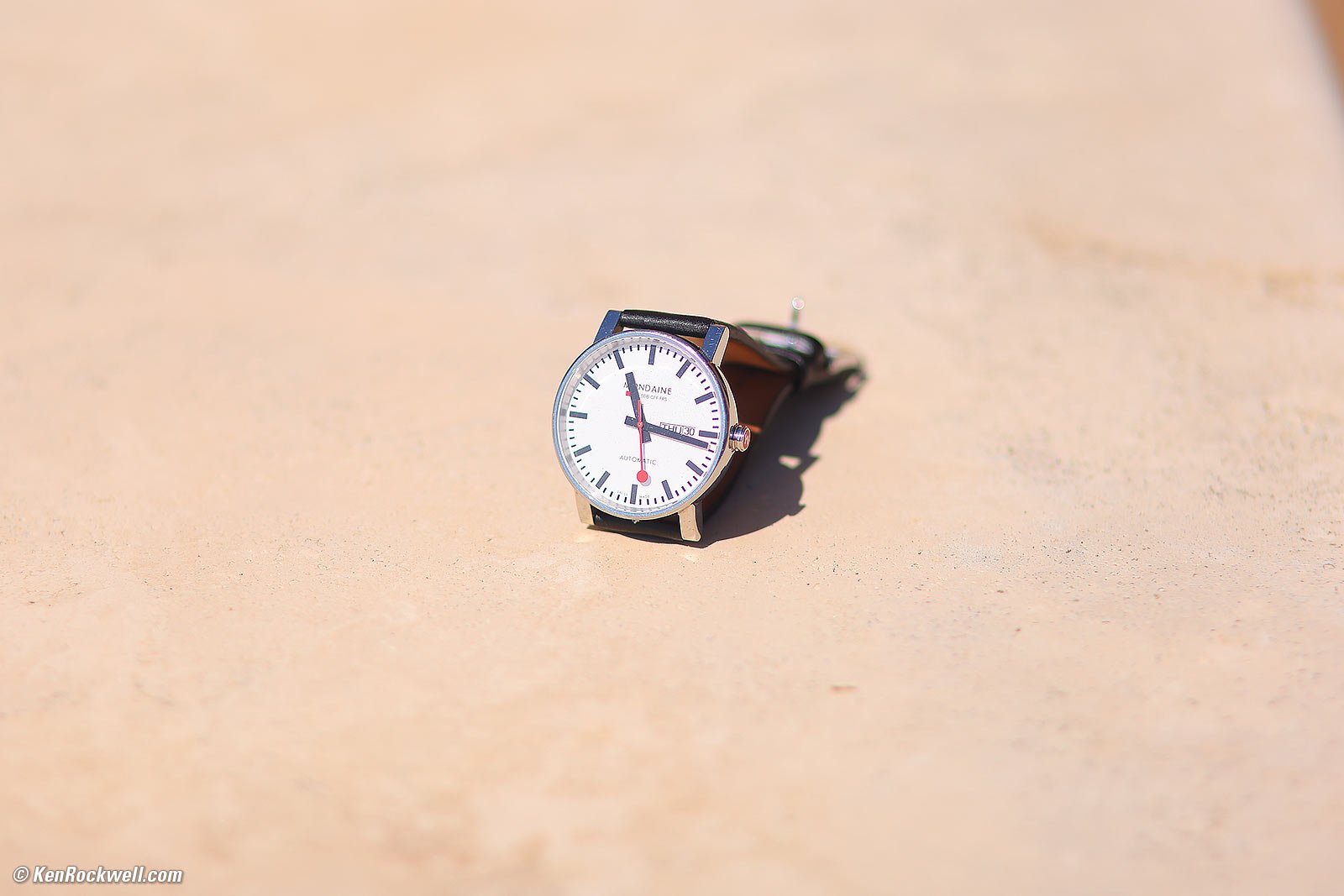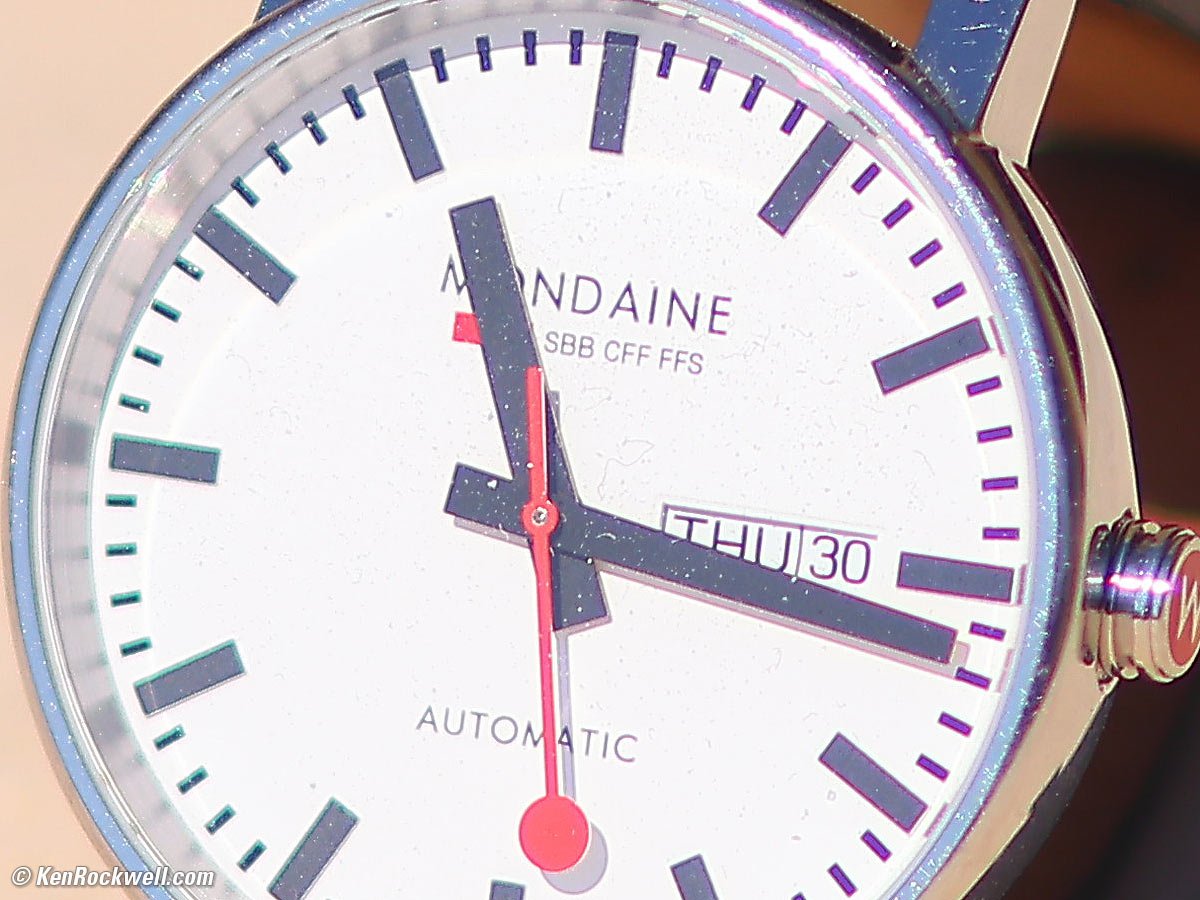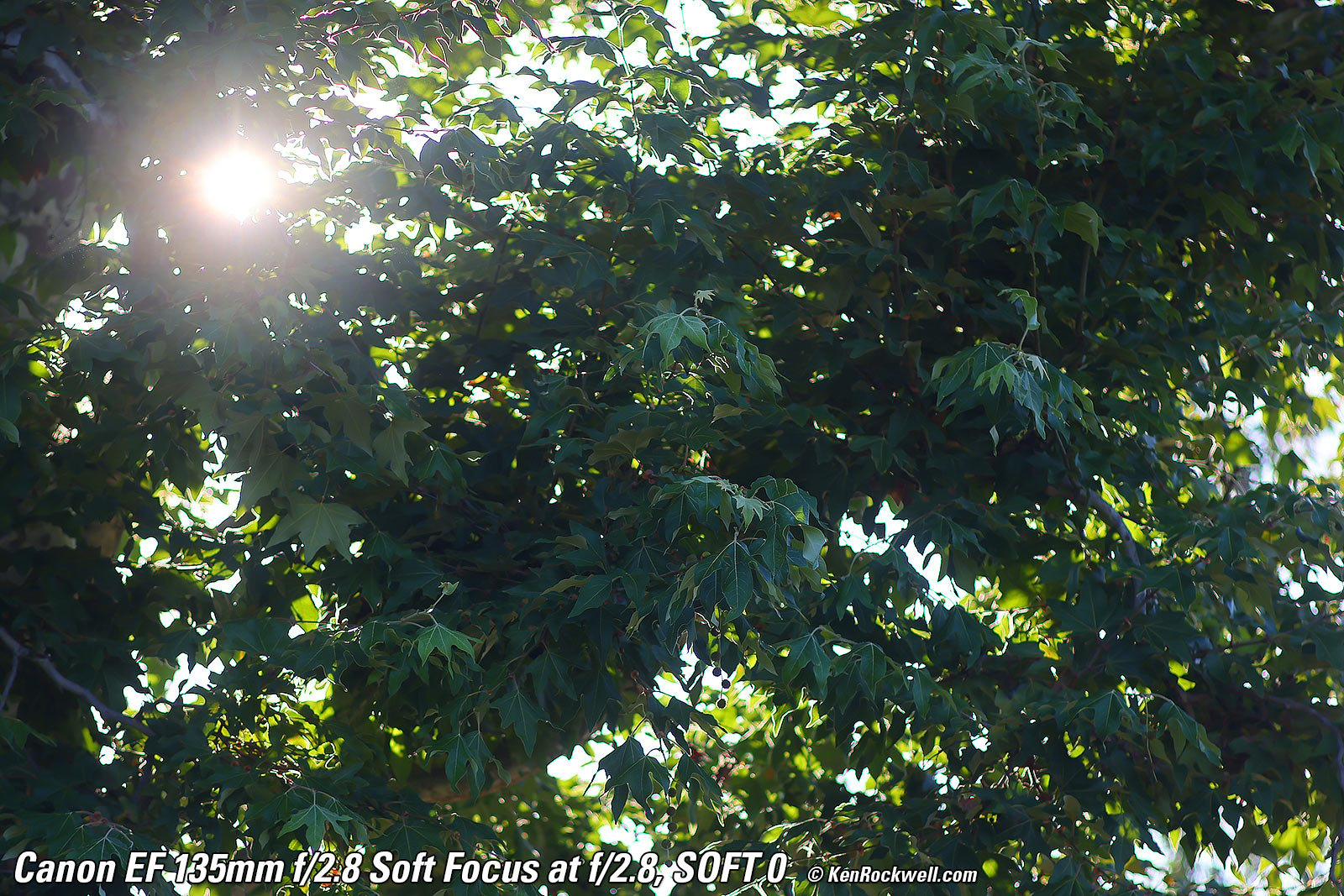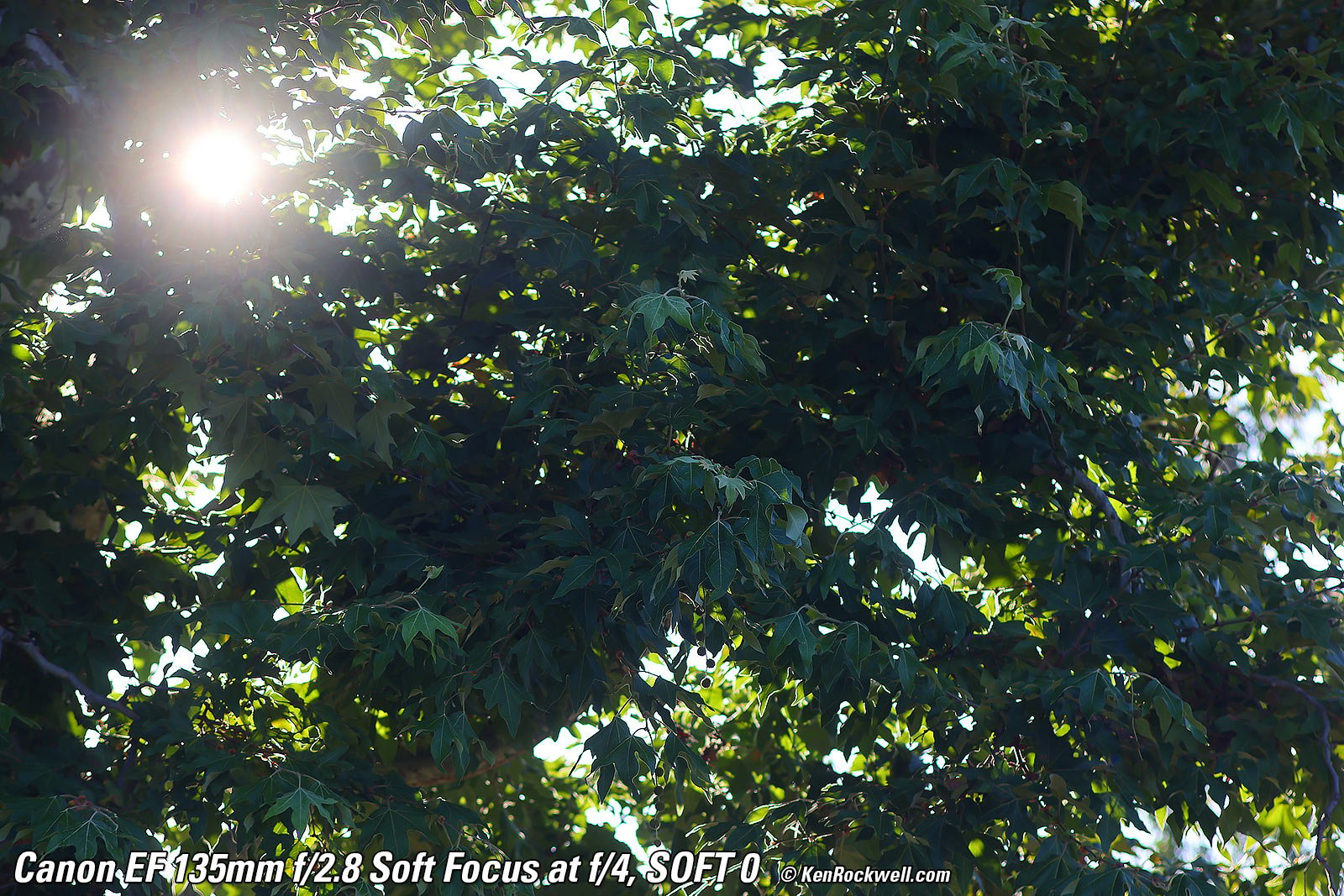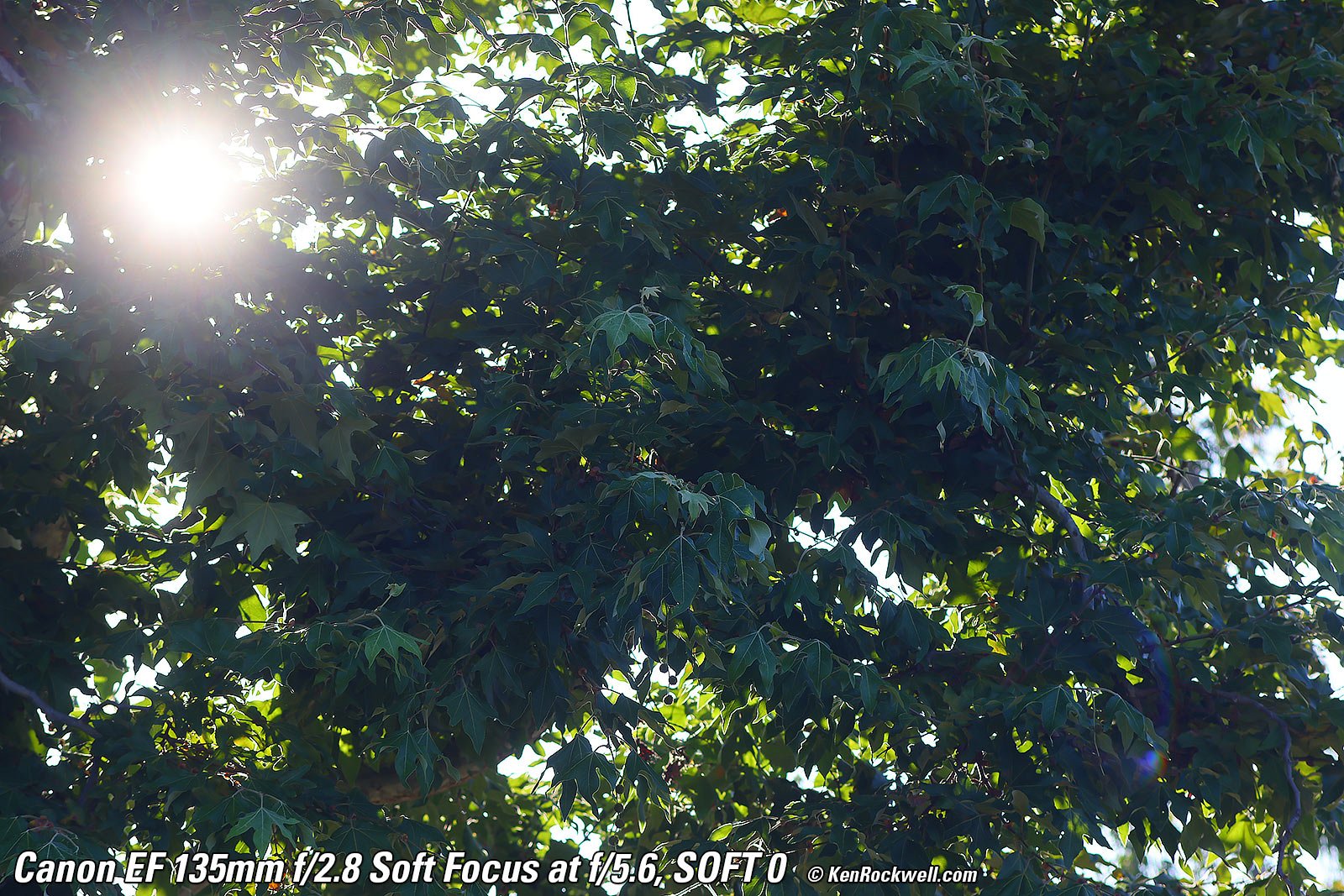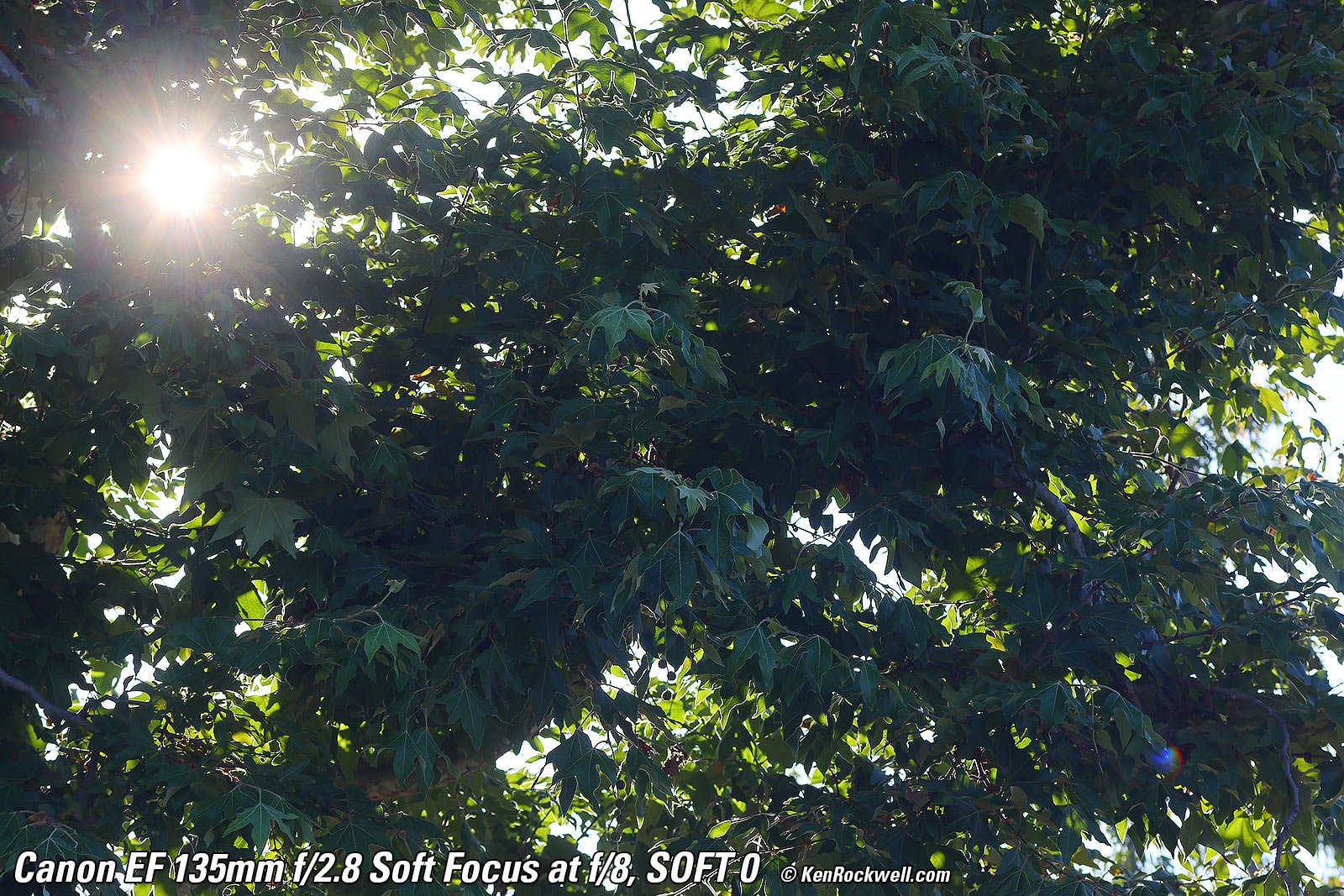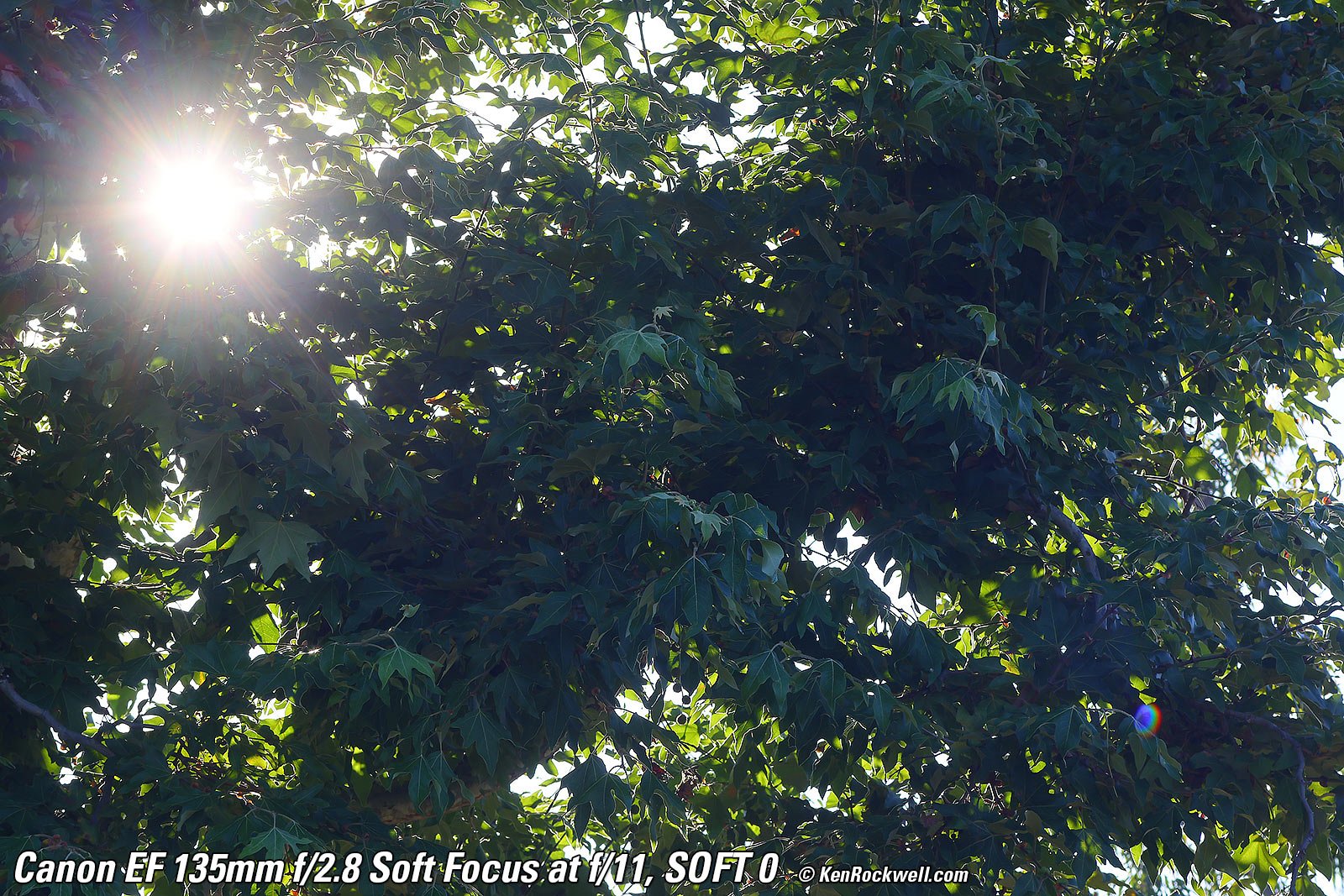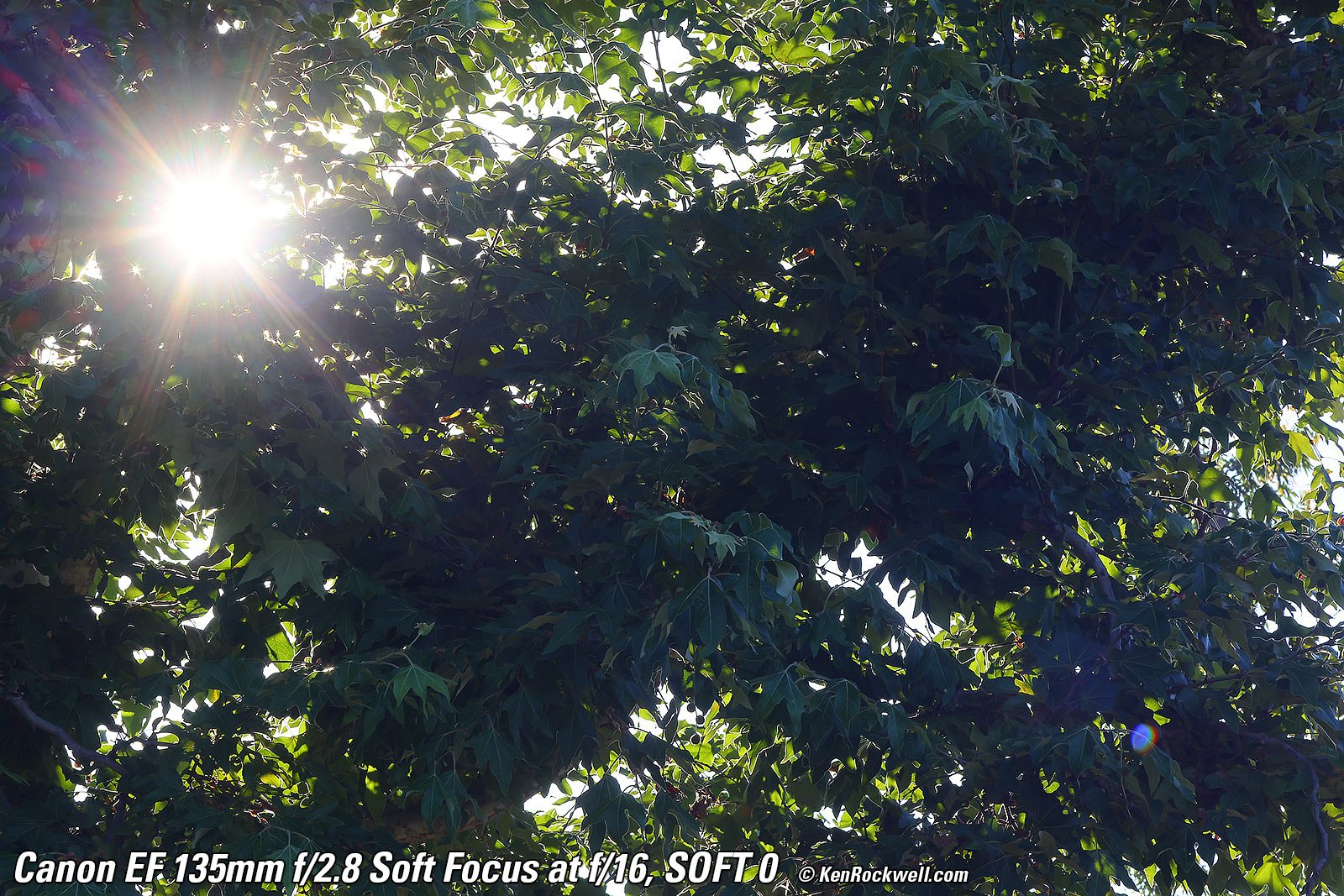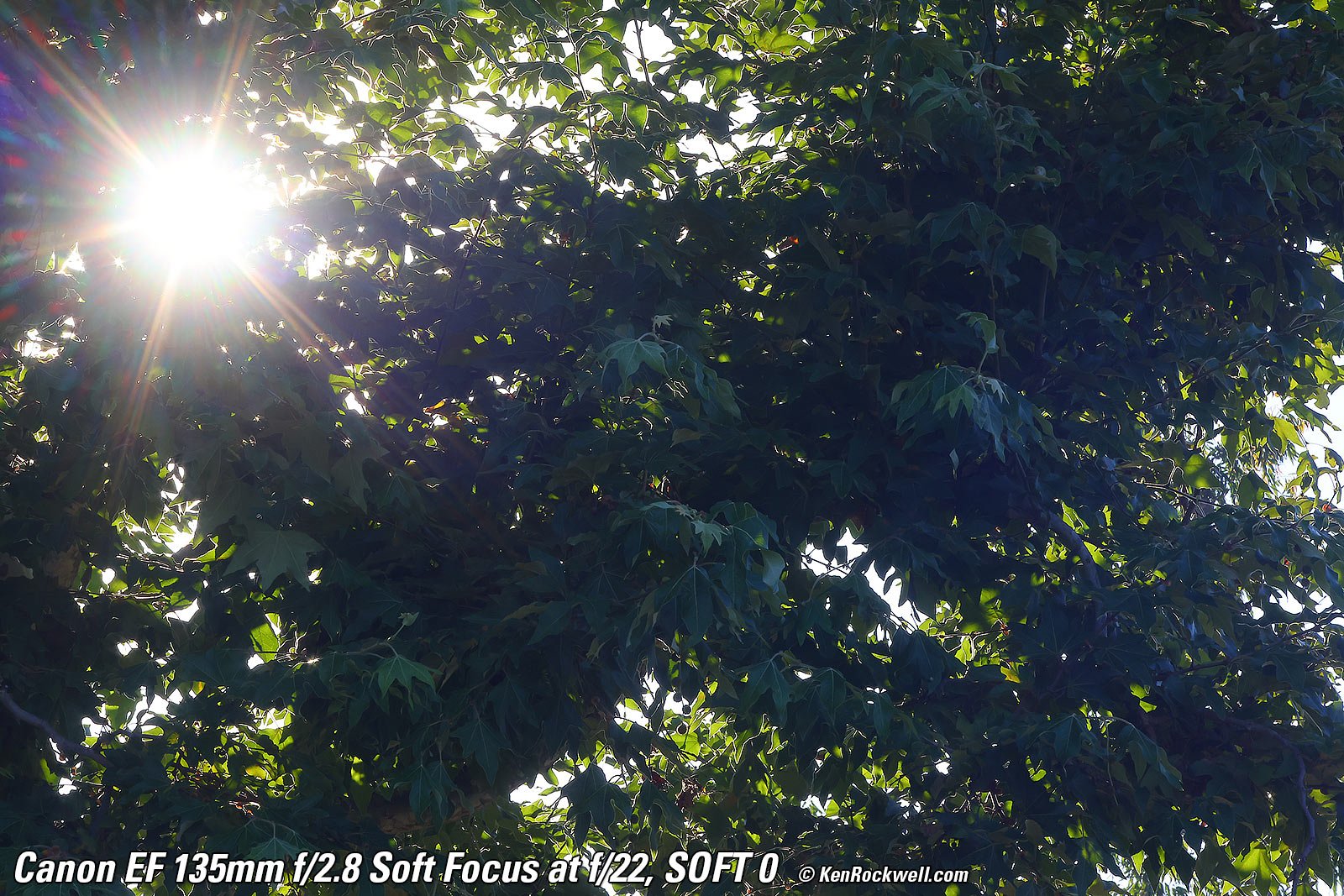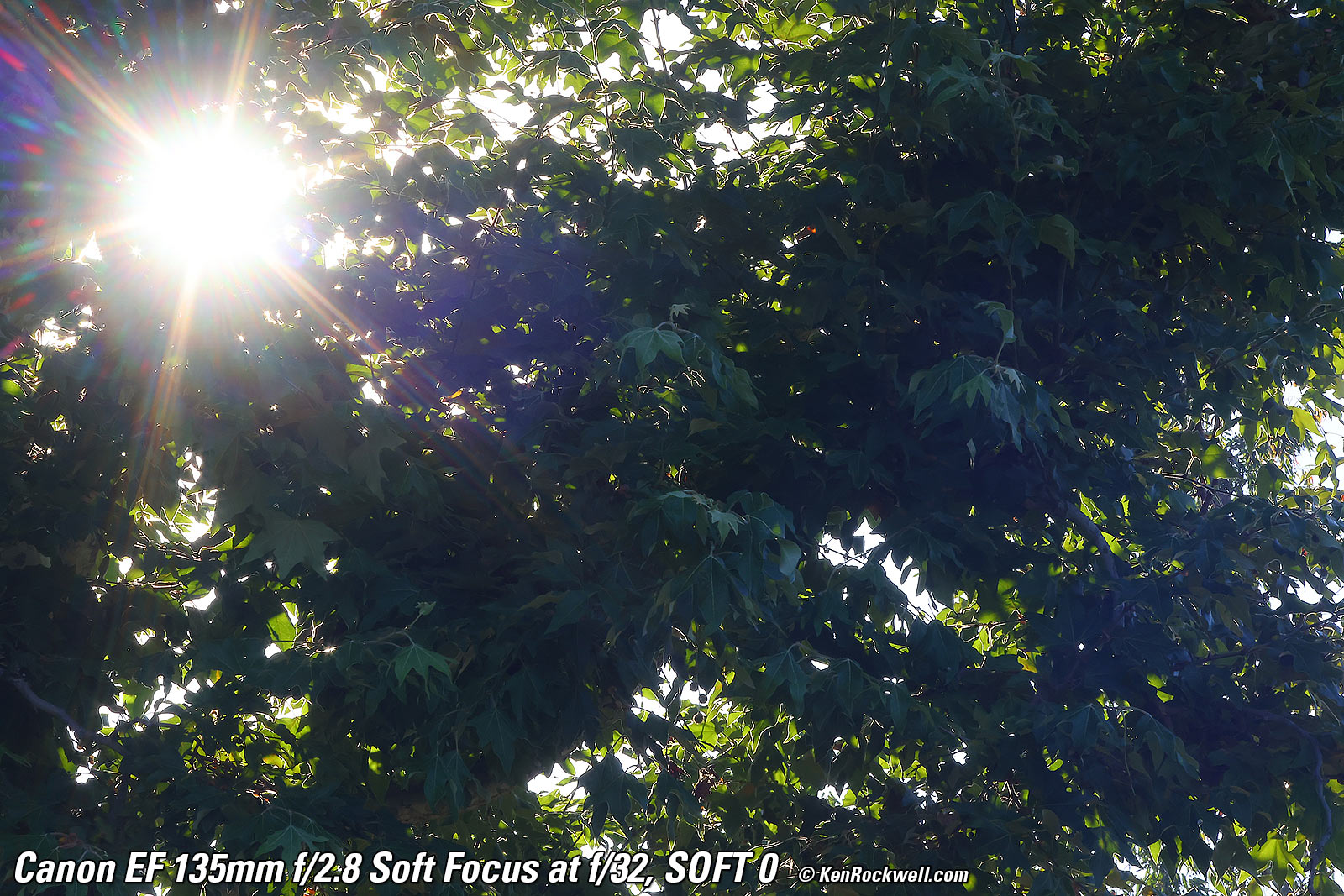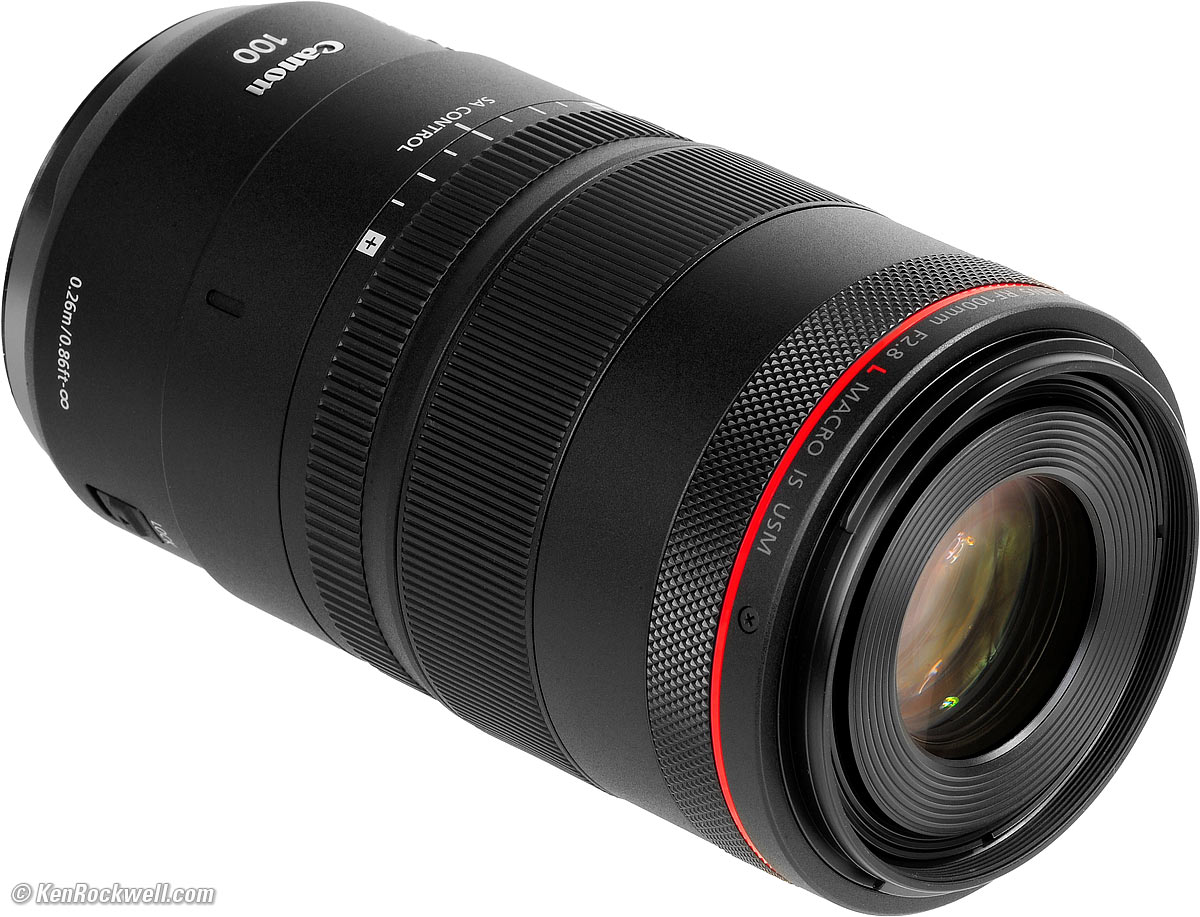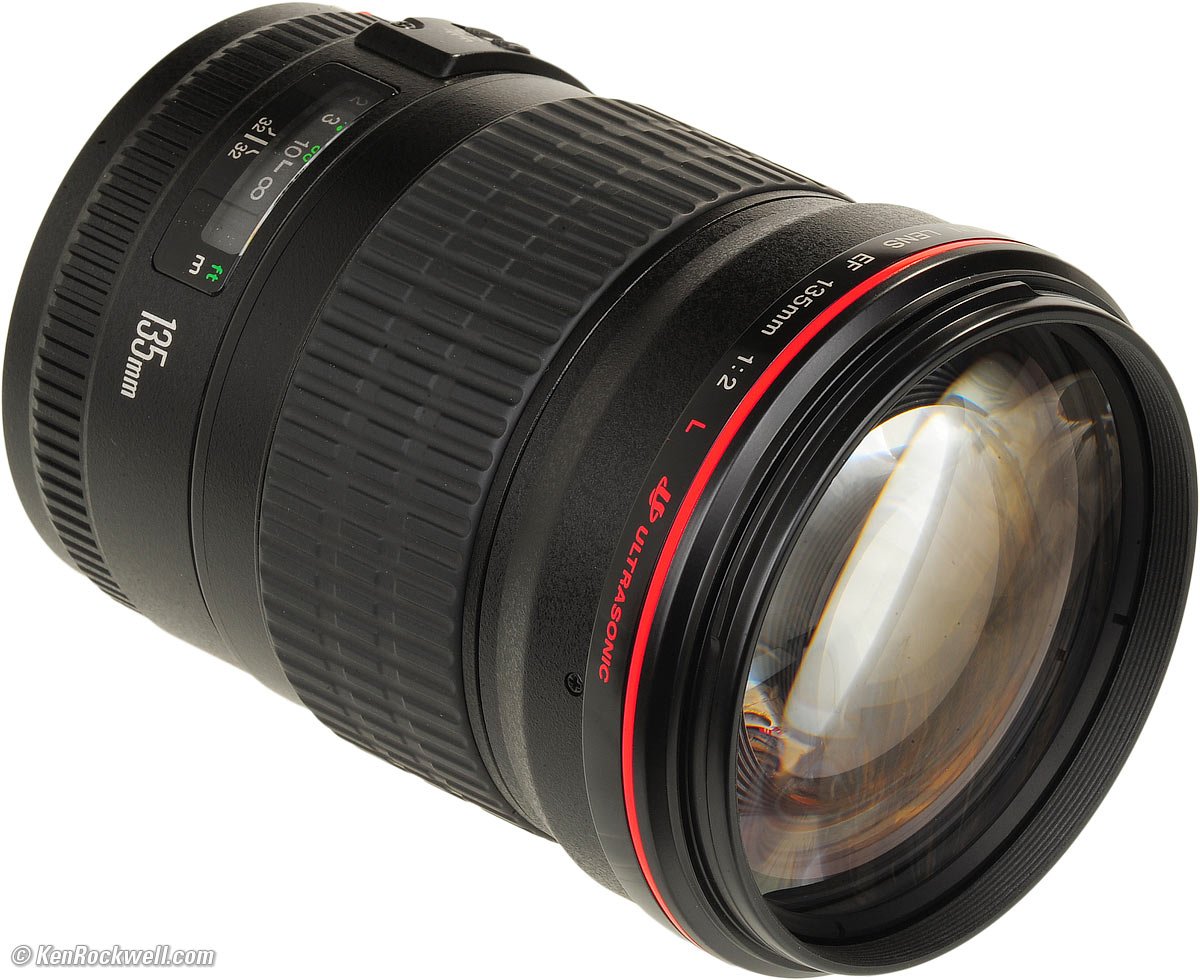Canon EF 135mm f/2.8
Full-Frame Soft Focus (1987~2013)
Sample Images Intro New Good Bad Missing
Compatibility Specifications Performance
Compared User's Guide Recommendations
Canon EF 135mm f/2.8 Soft Focus (metal 52mm filter thread, 13.6 oz./384g, 4¼'/1.3m close focus, about $150 used if you know How to Win at eBay). bigger. I got mine used at eBay, and you can get it at Amazon, too.
This all-content, junk-free website's biggest source of support is when you use those or any of these links to approved sources when you get anything, regardless of the country in which you live. Thanks for helping me help you! Ken.
October 2021 Better Pictures Canon EF Lenses RF Lenses Mirrorless Flash All Reviews
Newest Canon RF 100mm f/2.8L IS Macro
Why Fixed Lenses Take Better Pictures
Sample Images top
Sample Images Intro New Good Bad Missing
Compatibility Specifications Performance
Compared User's Guide Recommendations
More samples throughout this review at Bokeh, Soft Focus, Macro, Spherochromatism and Sunstars.
These are just snapshots; my real work is in my Gallery.
These are shot hand-held as NORMAL JPGs; no tripods, FINE JPGs or RAW CR3 files were used or needed.
At f/2.8 (No Softening)
Canary Palm, 8:16 AM, 30 September 2021. Canon R5, Canon EF 135mm f/2.8 Soft Focus wide-open at f/2.8, no softening, 1/2,000 at Auto ISO 100, -0.7 stops exposure compensation (LV 14.0), Perfectly Clear. bigger or camera-original 45 MP © JPG file (12 MB).
At f/11 (No Softening)
Canary Palm, 8:16 AM, 30 September 2021. Canon R5, Canon EF 135mm f/2.8 Soft Focus at f/11, no softening, 1/125 at Auto ISO 100, -0.7 stops exposure compensation (LV 14.0), Perfectly Clear. bigger or camera-original 45 MP © JPG file (14 MB).
Introduction top
Sample Images Intro New Good Bad Missing
Compatibility Specifications Performance
Compared User's Guide Recommendations
|
I buy only from these approved sources. I can't vouch for ads below. |
The Canon EF 135mm f/2.8 is a sharp, compact, fixed telephoto lens with a fully adjustable soft-focus portrait feature.
The adjustable soft focus feature adds soft, glowing halos around brighter parts of your image. It's great for portraiture because this glow helps cover facial blemishes and fill wrinkles.
It works perfectly on all Canon DSLRs and all Canon 35mm EOS cameras. It works perfectly on all Canon Mirrorless with an adapter.
Canon EF 135mm f/2.8 Soft Focus. bigger.
Leave the SOFT ring set to 0 and it's a fast, sharp lens. Set it to 1 or 2 and it adds soft, glowing halos around brighter parts of your image.
The soft focus effect is the same as the effect of the SA CONTROL in Canon's newest RF 100mm f/2.8L IS Macro. With both these lenses the SOFT effect is strongest at f/2.8 and becomes weaker as stopped down.
I got my 135mm Soft Focus used at eBay (How to Win at eBay), and you can try Amazon, too.
New intro top
 Canon's first and only 135mm Soft Focus lens (Canon's first soft focus lens was the manual focus FD 85mm f/2.8).
Canon's first and only 135mm Soft Focus lens (Canon's first soft focus lens was the manual focus FD 85mm f/2.8).
Good intro top
 Sharp when set to SOFT 0.
Sharp when set to SOFT 0.
 Fast f/2.8.
Fast f/2.8.
 Stops down to f/32 for complete depth-of-field control.
Stops down to f/32 for complete depth-of-field control.
 Compact.
Compact.
 Lightweight.
Lightweight.
 Metal 52mm filter thread.
Metal 52mm filter thread.
 Front rubber bumper.
Front rubber bumper.
 Inexpensive: only about $150 if you know How to Win at eBay.
Inexpensive: only about $150 if you know How to Win at eBay.
 Same soft effect as the far more expensive RF 100mm f/2.8L IS Macro, with a better (longer) focal length for portraiture.
Same soft effect as the far more expensive RF 100mm f/2.8L IS Macro, with a better (longer) focal length for portraiture.
 Works perfectly on the newest Mirrorless cameras with a simple EF to RF adapter.
Works perfectly on the newest Mirrorless cameras with a simple EF to RF adapter.
 Even though it came out in 1987, my sample from 1993 has complete lens correction data recognized in my EOS R5! You may need to load this data into older DSLRs manually.
Even though it came out in 1987, my sample from 1993 has complete lens correction data recognized in my EOS R5! You may need to load this data into older DSLRs manually.
 Made in Japan.
Made in Japan.
 100% U.S.A.-based high-quality technical support at (800) OK-CANON.
100% U.S.A.-based high-quality technical support at (800) OK-CANON.
Bad intro top
 No instant manual-focus override; you have to move the AF-M switch any time you want to switch modes.
No instant manual-focus override; you have to move the AF-M switch any time you want to switch modes.
Missing intro top
 No Image Stabilization (that hadn't been invented back when this came out in 1987), but works great with cameras that have in-camera stabilization.
No Image Stabilization (that hadn't been invented back when this came out in 1987), but works great with cameras that have in-camera stabilization.
 No instant manual-focus override; that hadn't been invented back when this came out in 1987.
No instant manual-focus override; that hadn't been invented back when this came out in 1987.
 No high price, no problem!
No high price, no problem!
Compatibility top
Sample Images Intro New Good Bad Missing
Compatibility Specifications Performance
Compared User's Guide Recommendations
I got my 135mm Soft Focus used at eBay (How to Win at eBay), and you can try Amazon, too.
Mirrorless
Use an EF to RF adapter to use this on Canon's Full-Frame mirrorless cameras, with which it works perfectly.
Use the EOS-M adapter to use this on Canon's EOS-M mirrorless cameras.
Use the Fringer EF-NZ adapter to use this on Nikon Z cameras.
DSLR
This lens works flawlessly on every Canon DSLR, no adapter needed.
35mm Autofocus (EOS)
This lens works flawlessly on every Canon EOS 35mm SLR made since 1987, no adapter needed.
35mm Manual Focus (FD)
This lens can't mount on any manual-focus 35mm camera.
Specifications top
Sample Images Intro New Good Bad Missing
Compatibility Specifications Performance
Compared User's Guide Recommendations
I got my 135mm Soft Focus used at eBay (How to Win at eBay), and you can try Amazon, too.
Name specifications top
Canon calls this the EF 135mm f/2.8 Soft Focus:
EF: Electronic Focus, as all Canon's lenses have been since 1987.
Soft Focus: Variable spherical aberration effect for soft halo-like glows.
Optics specifications top
Canon EF 135mm f/2.8 Soft Focus internal optical construction. Aspherical element.
7 elements in 6 groups.
1 aspherical element.
Internal focussing by moving the aspherical element.
Canon claims its design which moves only the one aspherical element (element 4) to focus gives a constant soft focus effect regardless of focussed distance. Most other lenses have spherical aberration which changes from one end of the focus range to the other.
Elements 2 and 3 move for the SOFT settings.
Super Spectra multicoating.
Diaphragm specifications top
At f/2.8. bigger. |
At f/5.6.bigger. |
6 rounded blades.
Electronically actuated.
Stops down to f/32.
Filters specifications top
Metal 52mm filter thread.
Coverage specifications top
Full-Frame (24 × 36mm), 35mm film (24 × 36mm) and APS-C (16 × 24mm).
Focal Length specifications top
135 mm.
When used on Canon's APS-C cameras, it sees the same angle of view as a 200 mm lens sees when used on a full-frame or 35mm camera.
See also Crop Factor.
Angles of View (Full Frame) specifications top
18º diagonal.
15º horizontal.
10º vertical.
Autofocus specifications top
Arc-Form Drive (AFD) motor.
No external movement as focussed, so no air or dust is sucked in.
Focus Scale specifications top
Yes.
Infinity Focus Stop specifications top
No.
You have to focus somehow to get precise focus at infinity, just like at every other distance.
It shifts as the SOFT CONTROL is moved.
Depth of Field Scale specifications top
Yes.
Infrared Focus Index specifications top
Yes.
Close Focus (distance from subject to image plane) specifications top
4¼ feet (1.3 meters).
Maximum Reproduction Ratio specifications top
1:8.1 (0.124 ×).
Extension Tubes (optional) specifications top
The Canon Extension Tube EF12 II gives a 0.09 ~ 0.22× magnification range.
The Canon Extension Tube EF25 II gives a 0.20 ~ 0.33× magnification range.
Caps specifications top
Canon EOS "E" rear cap. Also works with Rear Lens Dust Cap RF (p/n 2962C001) for the RF lenses.
Hood specifications top
The clip-on plastic ET-65 II hood was optional when new.
Today's ET-65 III hood is the same thing, except with black paint inside rather than the black fuzz inside the ET-65 II.
Cases specifications top
In 1987 this shipped with an "Exclusive Hard Case."
Later it shipped with an ES-C13 "Bibendum" leather or leather-like case, and lastly with an LP-1016 pseudo suede sack.
Size specifications top
2.72" ø maximum diameter × 3.87" extension from flange.
69.2 mm ø maximum diameter × 98.4 mm extension from flange.
Weight specifications top
13.552 oz. (384.17 g) actual measured weight.
Rated 13.7 oz. (390 g).
ET-65 II Hood: 1.085 oz. (30.8g), actual measured weight.
Quality specifications top
Canon EF 135mm f/2.8 Soft Focus. bigger.
Made in Japan.
Announced specifications top
October 1987.
Discontinued specifications top
April 2013.
Included specifications top
Canon EOS "E" rear cap, included. Also works with Rear Lens Dust Cap RF (p/n 2962C001) for the RF lenses.)
Price, U. S. A. specifications top
October 2021
About $150 used if you know How to Win at eBay.
October 1987
$450 USD list price.
47,500 yen with case.
Performance top
Sample Images Intro New Good Bad Missing
Compatibility Specifications Performance
Compared User's Guide Recommendations
Overall Autofocus Manual Focus Focus Shift
Breathing Bokeh Soft Focus Distortion
Ergonomics Falloff Filters Flare & Ghosts
Lateral Color Fringes Lens Corrections Macro
Mechanics Sharpness Spherochromatism
I got my 135mm Soft Focus used at eBay (How to Win at eBay), and you can try Amazon, too.
Overall performance top
It's very sharp shot normally, but this thirty-year-old design isn't quite as crazy-sharp wide-open as the legendary EF 135mm f/2 L — but stopped down they're the same.
The soft focus effect is the same as the far more expensive Canon RF 100mm f/2.8L IS Macro, and 135mm is much better focal length for portraits.
Autofocus performance top
Autofocus speed is moderate.
The AFD (Arc-Form Drive) motor makes some sound as it works.
Manual Focus performance top
Manual focus requires sliding the AF-M switch to M.
Use the ring near the rear of the lens for manual focus.
Focus Shift performance top
The focus shifts when the SOFT control is moved.
Canon EF 135mm f/2.8 Soft Focus. bigger.
See the lines between the SOFT control and the focus window? Those are different focus indices for each SOFT setting. Things are normal at SOFT 0, while at SOFT 1 or SOFT 2 you can focus even closer than 4¼' (1.3 meters). Likewise, at SOFT 0 you can focus well past infinity.
Focus works normally with SOFT set to 0, but it's a good idea to see if you get exactly the autofocus results you want with SOFT set to 1 or 2. Sometimes you may get more accurate focus with magnified live-view manual focus at the SOFT 1 or 2 settings.
It also depends on the exact effect you prefer with SOFT 1 or 2. I prefer the sharpest core image but that tends to have greener fringes from spherochromatism than the result I get from letting autofocus do its thing.
Focus Breathing performance top
Focus breathing is the image changing size as focused in and out. It's important to cinematographers that the image not breathe because it looks funny if the image changes size as focus gets pulled back and forth between actors. If the lens does this, the image "breathes" by growing and contracting slightly as the dialog goes back and forth.
The image from this lens gets larger as focussed more closely.
The image from this lens gets smaller as SOFT is set to 1 or 2 after refocusing.
Bokeh performance top
Bokeh, the feel, character or quality of out-of-focus areas as opposed to how far out of focus they are, is excellent at SOFT 0, and improves at SOFT 1 and SOFT 2.
Here are photos from headshot distance wide-open. I'm focused on the DAVIS logo. Click any for the full-resolution files:
Made-in-U. S. A. Davis 6250 weather station, 16 September 2021. Canon EOS R5, EF to RF Ring Adapter, Canon EF 135mm f/2.8 Soft Focus at 1/4,000 , 1/2,000 , 1/1,000 and 1/250 at Auto ISO 100 (LV 15.0 for all).
Click any for the full-resolution file.
As always, if you want to throw the background as far out of focus as possible, shoot at f/2.8 and get as close as possible. The SOFT 1 and SOFT 2 settings make backgrounds even softer, too.
Soft Focus performance top
This is a normal, sharp lens when set to SOFT 0.
SOFT 1 is soft, and SOFT 2 is softer.
It locks at settings of 0, 1 and 2. Pull the unlock lever towards you to unlock and rotate the big rubber SOFT CONTROL. You can use any intermediate setting, but it won't lock.
This softness isn't so much a reduction of resolution as a soft glow added around brighter areas that helps conceal small, dark defects like wrinkles and skin defects.
The SOFT effect is greatest at f/2.8 and lessens greatly at smaller apertures. It's gone by f/8 or f/11.
In other words, you control the SOFT effect with both the SOFT CONTROL as well as with aperture.
Since the SOFT effect varies so much with aperture, it is critical to use your depth-of-field preview to preview the SOFT effect.
Auto and manual focus is the usual at SOFT 0, but at SOFT 1 or SOFT 2 you may get more accurate focus with magnified live-view manual focus. Try it yourself and see; the softness can sometimes add slight focus errors.
Here are shots from headshot distance. I'm focussed on the DAVIS logo. Click any for the full-resolution image:
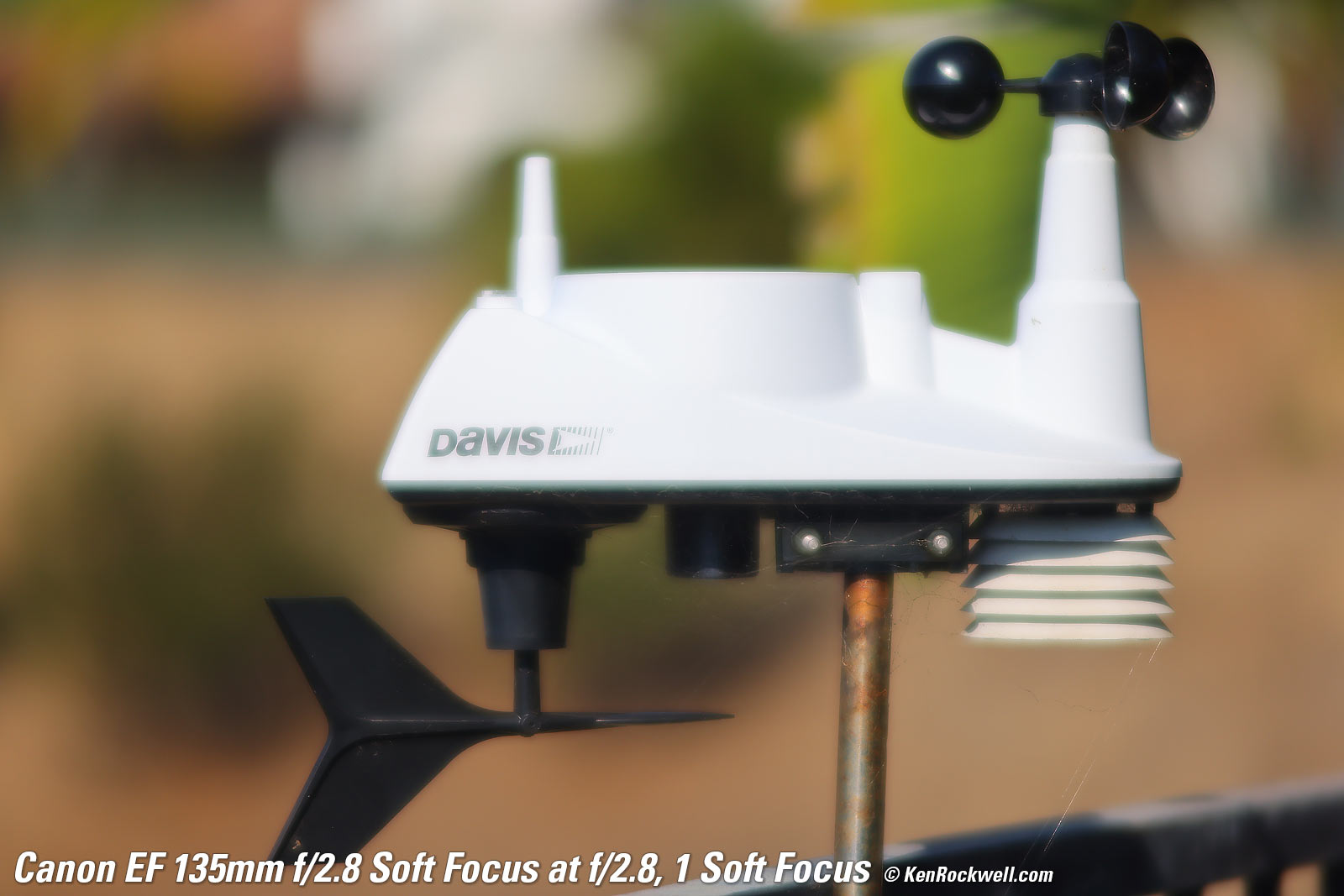
Click any for the full-resolution image.
Distortion performance top
There is moderate pincushion distortion which goes away with the camera's distortion correction turned ON.
For more critical scientific use, use a correction factor of -2.00 in Photoshop's lens correction filter to correct the distortion completely if the camera wasn't set to correct it.
With Distortion Correction ON in my Canon EOS R5, use a correction factor of -0.75 in Photoshop's lens correction filter to correct the distortion completely.
These aren't facts or specifications, they are the results of my research that requires hours of photography and calculations on the resulting data.
Ergonomics performance top
Canon EF 135mm f/2.8 Soft Focus. bigger. |
Canon EF 135mm f/2.8 Soft Focus. bigger. |
The big rubber ring is the SOFT FOCUS CONTROL. 0 is a normal lens, while 1 and 2 are weaker and stronger SOFT effects. Details at SOFT FOCUS.
It locks at 0, 1 and 2 and it's OK to set it anywhere, but it won't lock in-between settings
The focus ring is the much smaller ring behind the focus-distance window.
The AF-M and SOFT UNLOCK slide switches fall right under my thumb, bravo!
Falloff performance top
Falloff is invisible.
I've greatly exaggerated the falloff by shooting a gray field and placing these on a gray background; it won't look this bad in actual photos of real things:
Falloff on Full-Frame at infinity, SOFT 0, EOS R5 correction ON.
© 2021 KenRockwell.com. All rights reserved. |
On 35mm film or if you turn off lens corrections, there is just a tiny bit of falloff at f/2.8, and it goes away by f/4.
Again I've greatly exaggerated the falloff by shooting a gray field and placing these on a gray background:
Falloff on Full-Frame and 35mm at infinity, SOFT 0, no correction.
© 2021 KenRockwell.com. All rights reserved. |
Filters, use with performance top
There's no need for thin filters. I can stack about two inches of regular 52mm filters with no vignetting on full frame!
Go ahead and use your standard rotating polarizer and grad filters.
Flare & Ghosts performance top
This is a simple lens. Flare and ghosts are no problem.
See examples at Sunstars, which is an extreme case that shows even the slightest ghosting.
Lateral Color Fringes performance top
There are no color fringes when shot as JPG with the default Chromatic Aberration Correction left ON.
If you go out of your way to turn this OFF (or shoot raw and then use non-manufacturer software to process that data into images) then there are just the slightest magenta-red/yellow-green fringes, and these are mostly invisible even seen at 200% from my 45 megapixel EOS R5.
Especially for a 30-year-old design only intended to work on film, this is great performance.
There is spherochromatism, which can cause color fringes on things that aren't in perfect focus at large apertures. Spherochromatism is a completely different aberration in a different dimension than lateral color fringes.
Lens Corrections performance top
Other cameras may vary, but my EOS R5, EOS R6 and EOS RP all have options to correct for falloff (Peripheral Illumination Correction), Distortion and a Digital Lens Optimizer which correct for a suite of other aberrations including diffraction and lateral color. The EOS R has this, too; I just don't have one handy to check the specifics with this lens.
If you turn off the Digital Lens Optimizer, you are then offered à la carte ON/OFF options for Chromatic Aberration Correction and Diffraction Correction — at least on my EOS R5, EOS R6 and EOS RP.
On older DSLRs you may need to load a lens profile manually with Canon's EOS Utility software on your computer, and if you do, you've got all the correction your camera can give you.
Bravo, Canon!
Macro Performance performance top
This lens doesn't get very close. If you want an superb classic macro from the same era for a budget price, get the superb Canon EF 100mm f/2.8 Macro (1990-2000), or for macro with soft focus on mirrorless, get the newest Canon RF 100mm f/2.8L IS Macro.
Wide-Open at f/2.8
Casio G-Shock Solar Atomic Watch at close-focus distance, 30 September 2021. Canon EOS R5, EF to RF Ring Adapter, Canon EF 135mm f/2.8 Soft Focus at1/2,500 at Auto ISO 100, +1.3 stops exposure compensation (LV 14.4). bigger or camera-original © file.
While it's sharp even wide-open at f/2.8, spherochromatism puts colors fringes on anything not in perfect focus, which is mostly everything at macro distances:
1,200 × 900 pixel (6.8× magnification) crop from above. bigger or camera-original © file.
If this 1,200 × 900 pixel crop is about 3" (7.5cm) wide on your screen, the complete image would print at a large 14 × 21″ (35 × 55 cm) at this same high magnification.
If this 1,200 × 900 pixel crop is about 6" (15cm) wide on your screen, the complete image would print at a huge 27½ × 41¼″ (70 × 105 cm) at this same high magnification.
If this 1,200 × 900 pixel crop is about 12" (30cm) wide on your screen, the complete image would print at a mammoth 55 × 82½″ (1.4 × 2.1 meters) at this same extremely high magnification!
At f/8
It's much sharper at f/8, mostly because there's more in focus and spherochromatism is gone:
Casio G-Shock Solar Atomic Watch at close-focus distance, 30 September 2021. Canon EOS R5, EF to RF Ring Adapter, Canon EF 135mm f/2.8 Soft Focus at1/320 at Auto ISO 100, +1.3 stops exposure compensation (LV 14.4). bigger or camera-original © file.
1,200 × 900 pixel (6.8× magnification) crop from above. bigger or camera-original © file.
If this 1,200 × 900 pixel crop is about 3" (7.5cm) wide on your screen, the complete image would print at a large 14 × 21″ (35 × 55 cm) at this same high magnification.
If this 1,200 × 900 pixel crop is about 6" (15cm) wide on your screen, the complete image would print at a huge 27½ × 41¼″ (70 × 105 cm) at this same high magnification.
If this 1,200 × 900 pixel crop is about 12" (30cm) wide on your screen, the complete image would print at a mammoth 55 × 82½″ (1.4 × 2.1 meters) at this same extremely high magnification!
Mechanical Quality performance top
Canon EF 135mm f/2.8 Soft Focus. bigger.
It's got metal where it matters, like the filter ring, mount and some internals, and a plastic outer covering so it doesn't freeze to your finders in the cold.
Front Bumper
Rubber.
Filter Threads
Metal.
Optional ET-66 II Hood
Plastic clip-on.
Hood Mount
Metal.
Identity Ring
Metal.
SOFT Ring
Rubber-covered Plastic.
Barrel Exterior & Focus Distance Window
Plastic.
Focus Ring
Plastic.
Focus Helicoids
Might be metal!
Slide Switches
Plastic.
Identity
Printed around front of barrel, also "135mm" printed on top of barrel.
Internals
Seem like plastic and metal.
Dust Gasket at Mount
No.
Mount
Chromed metal.
Markings
Paint.
Serial Number
Canon EF 135mm f/2.8 Soft Focus. bigger.
Engraved and filled with paint on bottom of barrel.
Date Code
Stamped on the rear light shield.
Mine reads UH0102, meaning it was made at Canon's Utsunomiya, Japan plant in January 1993.
Noises When Shaken
Mild to moderate clunking.
Made in
Made in Japan.
Sharpness performance top
Lens sharpness has nothing to do with picture sharpness; every lens made in the past 100 years is more than sharp enough to make super-sharp pictures if you know what you're doing. The only limitation to picture sharpness is your skill as a photographer. It's the least talented who spend the most time worrying about lens sharpness and blame crummy pictures on their equipment rather than themselves. Skilled photographers make great images with whatever camera is in their hands; I've made some of my best images of all time with an irreparably broken camera! Most pixels are thrown away before you see them, but camera makers don't want you to know that.
If you're not getting ultra-sharp pictures with this, be sure not to shoot at f/22 or smaller where all lenses are softer due to diffraction, always shoot at ISO 100 or below because cameras become softer at ISO 200 and above, avoid shooting across long distances over land which can lead to atmospheric heat shimmer, be sure everything is in perfect focus, set your camera's sharpening as you want it (I set mine to the maximum) and be sure nothing is moving, either camera or subject. If you want to ensure a soft image with any lens, shoot at f/16 or smaller at ISO 1,600 or above at default sharpening in daylight of subjects at differing distances in the same image.
People worry waaaaay too much about lens sharpness. It's not 1968 anymore when lenses often weren't that sharp and there could be significant differences among them.
Even this 1980s-design lens is sharp; see the images at the top. Its biggest sharpness limitations are various chromatic aberrations. It's sharp pretty much everywhere at every aperture, limited of course by diffraction at the very smallest apertures. At f/2.8 spherochromatism and field curvature make this lens not usually as sharp as the newest lenses like the incredible EF 135mm f/2L, while stopped down it's just as good. In practice it tends to be sharpest in the far corners at f/11, and it's pretty good even wide open, just not as good in the far corners at f/2.8 as newer lenses.
MTF wide-open at f/2.8 (black) and at f/8 (blue), at 10 cyc/mm (bold) and 30 cyc/mm (light). Sagittal (solid) and meridional (dashed).
Spherochromatism performance top
Spherochromatism, also called secondary spherical chromatic aberration or "color bokeh," is an advanced form of spherical and chromatic aberration in a different dimension than lateral chromatic aberration. It happens mostly in fast normal and tele lenses when spherical aberration at the ends of the color spectrum are corrected differently than in the middle of the spectrum. Spherochromatism can cause colored fringes on out-of-focus highlights, usually seen as green fringes on backgrounds and magenta fringes on foregrounds. Spherochromatism is common in fast lenses of moderate focal length when shooting contrasty items at full aperture. It goes away as stopped down.
As expected for a 135mm f/2.8, it has a normal amount of spherochromatism:
Mondaine A132.30348.11SBB at close-focus distance, 30 September 2021.. Canon EOS R5, EF to RF Ring Adapter, Canon EF 135mm f/2.8 Soft Focus at1/3,200 at Auto ISO 100, +1 stop exposure compensation (LV 14.6). bigger or camera-original © file.
1,200 × 900 pixel (6.8× magnification) crop from above. bigger or camera-original © file.
If this 1,200 × 900 pixel crop is about 3" (7.5cm) wide on your screen, the complete image would print at a large 14 × 21″ (35 × 55 cm) at this same high magnification.
If this 1,200 × 900 pixel crop is about 6" (15cm) wide on your screen, the complete image would print at a huge 27½ × 41¼″ (70 × 105 cm) at this same high magnification.
If this 1,200 × 900 pixel crop is about 12" (30cm) wide on your screen, the complete image would print at a mammoth 55 × 82½″ (1.4 × 2.1 meters) at this same extremely high magnification!
Image Stabilization performance top
This lens has no Optical Image Stabilization (OIS, IS or VR (Vibration Reduction)), but works fine with in-camera stabilization.
"Percent Perfectly Sharp Shots" are the percentage of frames with 100% perfect tripod-equivalent sharpness I get when I'm shooting hand-held while free-standing with no support or bracing. Hand tremor is a random occurrence, so at marginal speeds some frames will be perfectly sharp while others will be in various stages of blur — all at the same shutter speed. This rates what percentage of shots are perfectly sharp, not how sharp are all the frames:
| % Perfectly Sharp Shots | 1/2 |
1/4 |
1/8 |
1/15 |
1/30 |
1/60 |
1/125 |
1/250 |
1/500 |
| EOS R5 Stabilization ON | 0 |
0 |
0 |
33 |
33 |
100 |
100 |
100 |
100 |
| Stabilization OFF | 0 |
0 |
0 |
0 |
0 |
17 |
25 |
100 |
100 |
I see a 2 stop real-world improvement on my stabilized Canon EOS R5, which is wonderfully useful when you see that in my case it lets me shoot at 1/60 and 1/125 with great results, rather than having to shoot at at least 1/250 without stabilization.
This is for perfect sharpness. For most uses you can shoot at much slower speeds and get great results, but looking at 200% on my computer at 45 MP shots, I get perfect results all the time at 1/60 which is very useful.
Sunstars performance top
With a 6-bladed rounded diaphragm, I get mild 6-pointed sunstars on brilliant points of light only at the smallest apertures.
Ignore the crazy rainbow dots at small apertures; these are sensor artifacts caused by taking a picture directly of the sun and exposing for the dark underside of a tree, and using that same tree to hide the sky to accentuate the stars.
Also here you can see that obviously this lens is super-sharp at f/2.8 when set to SOFT 0.
Click any to enlarge:
Click any to enlarge.
Compared top
Sample Images Intro New Good Bad Missing
Compatibility Specifications Performance
Compared User's Guide Recommendations
I got my 135mm Soft Focus used at eBay (How to Win at eBay), and you can try Amazon, too.
This is the least expensive autofocus soft-focus lens you can get from Canon. It works on every Canon camera made since 1987, possibly needing a simple adapter on the newest mirrorless cameras.
Versus the Canon RF 100mm f/2.8L IS Macro
Canon RF 100mm f/2.8L IS Macro.
The Canon RF 100mm f/2.8L IS Macro has the same soft focus effect.
The difference is that its SOFT ring is now called SA CONTROL and it also goes in two directions, rather than just the one (correct) direction of the 135mm's SOFT control.
The soft glowing halos from the RF 100mm f/2.8L IS Macro's SA CONTROL can be more color-neutral than the soft glowing halos from this 135mm, since the greater spherochromatism in this 135mm can color some edges inside the halos — a minor point.
The RF 100mm f/2.8L IS Macro adds macro capability as well as optical image stabilization, but it's bigger, almost twice as heavy, won't work on 35mm or DSLR cameras, and costs many times more than this basic 135mm.
Most importantly the RF 100mm f/2.8L IS Macro can have manual-focus override in some situations, which this 135mm never has.
135mm is a much better focal length for portraits because you can stand farther away for better perspective rendition.
Versus the Canon EF 135mm f/2L
Canon EF 135mm f/2L.
The EF 135mm f/2L is a much newer, bigger, heavier and more expensive lens which is faster and focuses closer. It's sharper in the lab, but has no soft focus or macro abilities.
User's Guide top
Sample Images Intro New Good Bad Missing
Compatibility Specifications Performance
Compared User's Guide Recommendations
I got my 135mm Soft Focus used at eBay (How to Win at eBay), and you can try Amazon, too.
SOFT CONTROL
I cover usage of the SOFT CONTROL in the performance section.
AF - M Switch user's guide top
Canon EF 135mm f/2.8 Soft Focus. bigger.
Unlike newer lenses, you have to move this switch to select between auto or manual focus. There is no automatic switching or instant override.
AF: Auto Focus. The manual focus ring is completely ignored!
M: Manual Focus. Autofocus is ignored.
Recommendations top
Sample Images Intro New Good Bad Missing
Compatibility Specifications Performance
Compared User's Guide Recommendations
I got my 135mm Soft Focus used at eBay (How to Win at eBay), and you can try Amazon, too.
This 135mm is the cheapskate's way to get soft focus in Canon. If money is no object and you're shooting mirrorless then by all means get the newest RF 100mm f/2.8L IS Macro, but for a better perspective from the longer focal length or just to have a small portrait lens to throw in your bag, this classic 135mm is still tops. Both the RF 100mm and this 135mm use the same technique to generate the soft focus effect and they both give the same soft effect.
I use a clear (UV) protective filter instead of a cap so I'm always ready to shoot instantly. I only use a cap when I throw this in a bag with other gear without padding — which is never. The UV filter never gets in the way, and never gets lost, either.
The very best protective filter is the Multicoated Hoya HD3 52mm UV which uses hardened glass and repels dirt and fingerprints. It's expensive, but it will last forever long after this lens is gone.
For less money, the most classic filter to use on a Nikon lens is of course the Nikon 52mm NC. The B+W 52mm 010 is an excellent filter, as are the multicoated B+W, the multicoated Hoya filters and even the most basic Hoya multicoated filter, but the Hoya HD3 is the toughest and the best.
Filters last a lifetime, so you may as well get the best. The Hoya HD3 stays cleaner than the others since it repels oil and dirt.
If I was working in nasty, dirty areas, I'd forget the cap, and use an uncoated 52mm Tiffen UV filter instead. Uncoated filters are much easier to clean, but more prone to ghosting.
For color slides like Fuji Velvia 50, I use an old Nikon A2 or new 52mm Hoya HMC 81A outdoors.
For B&W film outdoors, I'd use an old Nikon Y48 or O56, or a new 52mm Hoya HMC K2 Yellow or 52mm Hoya HMC Orange.
All these filters are just as sharp and take the same pictures, the difference is how much abuse they'll take and stay clean and stay in one piece. Since filters last a lifetime or more, there's no reason not to buy the best as it will last you for the next 40 years. Filters aren't throwaways like digital cameras which we replace every few years, like it or not. I'm still using filters I bought back in the 1970s!
I got my 135mm Soft Focus used at eBay (How to Win at eBay), and you can try Amazon, too.
This all-content, junk-free website's biggest source of support is when you use those or any of these links to approved sources when you get anything, regardless of the country in which you live. Thanks for helping me help you! Ken.
Thanks for helping me help you!
Ken.
© Ken Rockwell. All rights reserved. Tous droits réservés. Alle Rechte vorbehalten. Ken Rockwell® is a registered trademark.
Help Me Help You top
I support my growing family through this website, as crazy as it might seem.
The biggest help is when you use any of these links when you get anything. It costs you nothing, and is this site's, and thus my family's, biggest source of support. These places always have the best prices and service, which is why I've used them since before this website existed. I recommend them all personally.
If you find this page as helpful as a book you might have had to buy or a workshop you may have had to take, feel free to help me continue helping everyone.
If you've gotten your gear through one of my links or helped otherwise, you're family. It's great people like you who allow me to keep adding to this site full-time. Thanks!
If you haven't helped yet, please do, and consider helping me with a gift of $5.00.
As this page is copyrighted and formally registered, it is unlawful to make copies, especially in the form of printouts for personal use. If you wish to make a printout for personal use, you are granted one-time permission only if you PayPal me $5.00 per printout or part thereof. Thank you!
Thanks for reading!
Ken.
